Microchip Technology CX8703D JukeBlox Networked Media Module User Manual manual
MICROCHIP TECHNOLOGY INC. JukeBlox Networked Media Module manual
Contents
- 1. manual
- 2. user manual
manual
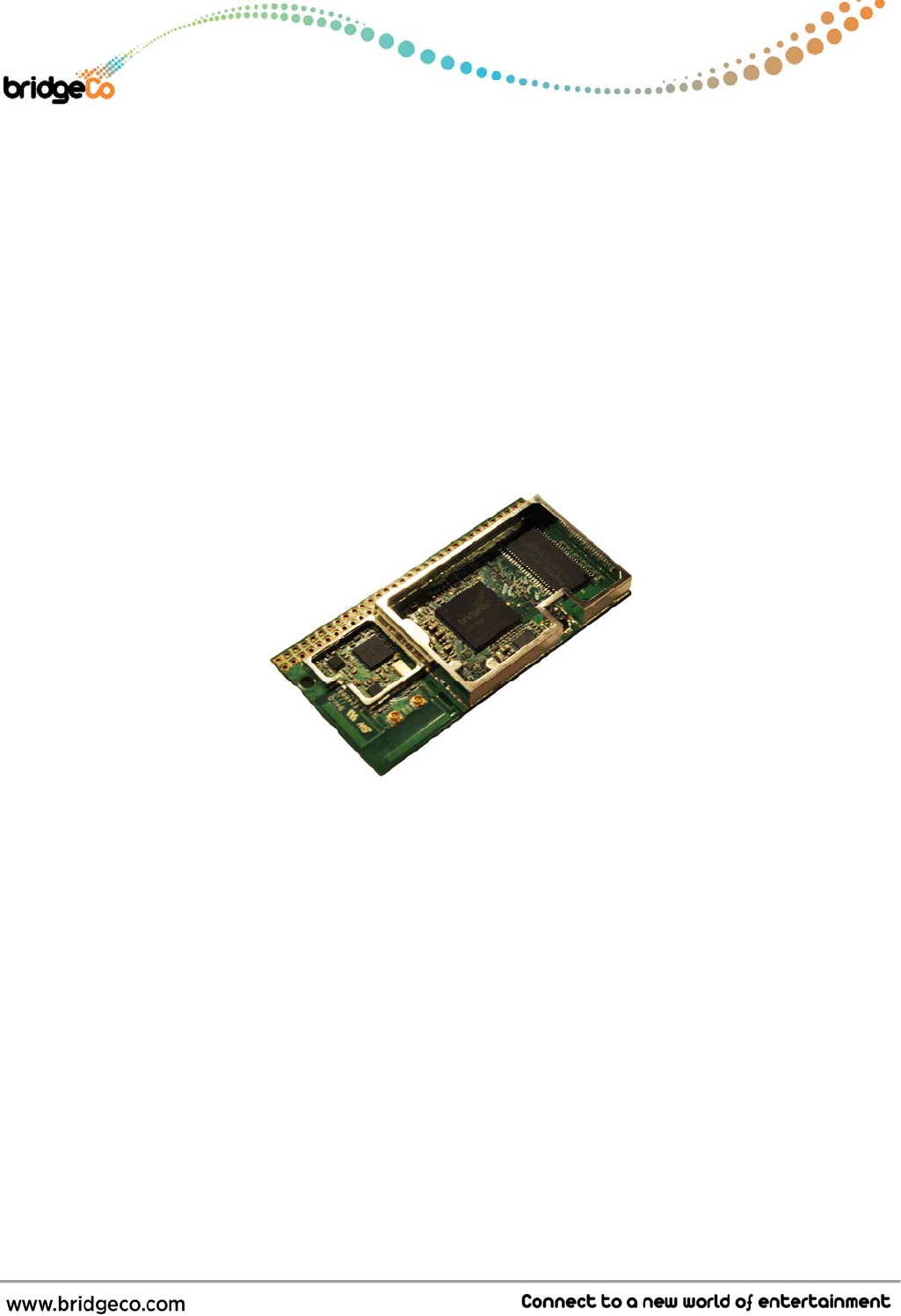
Preliminary Data Sheet: CX Series
JukeBlox Networked Media Modules
dat_CX860_CX870_1_7_datasheet_c.doc PRELIMINARY - CONFIDENTIAL Version 1.7 – May 13th 2011 - Page 1 of 23
JukeBlox Networked Media Module
CX Series
Preliminary Datasheet
Complete audio networking system on a small module
Integrated Ethernet + USB2.0
WiFi-certified 802.11b/g (optional)
Built-in strip antenna
Optional 2X Diversity Antenna
Glueless audio, video and control ports
FCC certified
Ideal for enabling network and USB audio playback for iPod
docks, audio systems, AV Receivers, active speaker systems,
internet radios, network playback adaptors
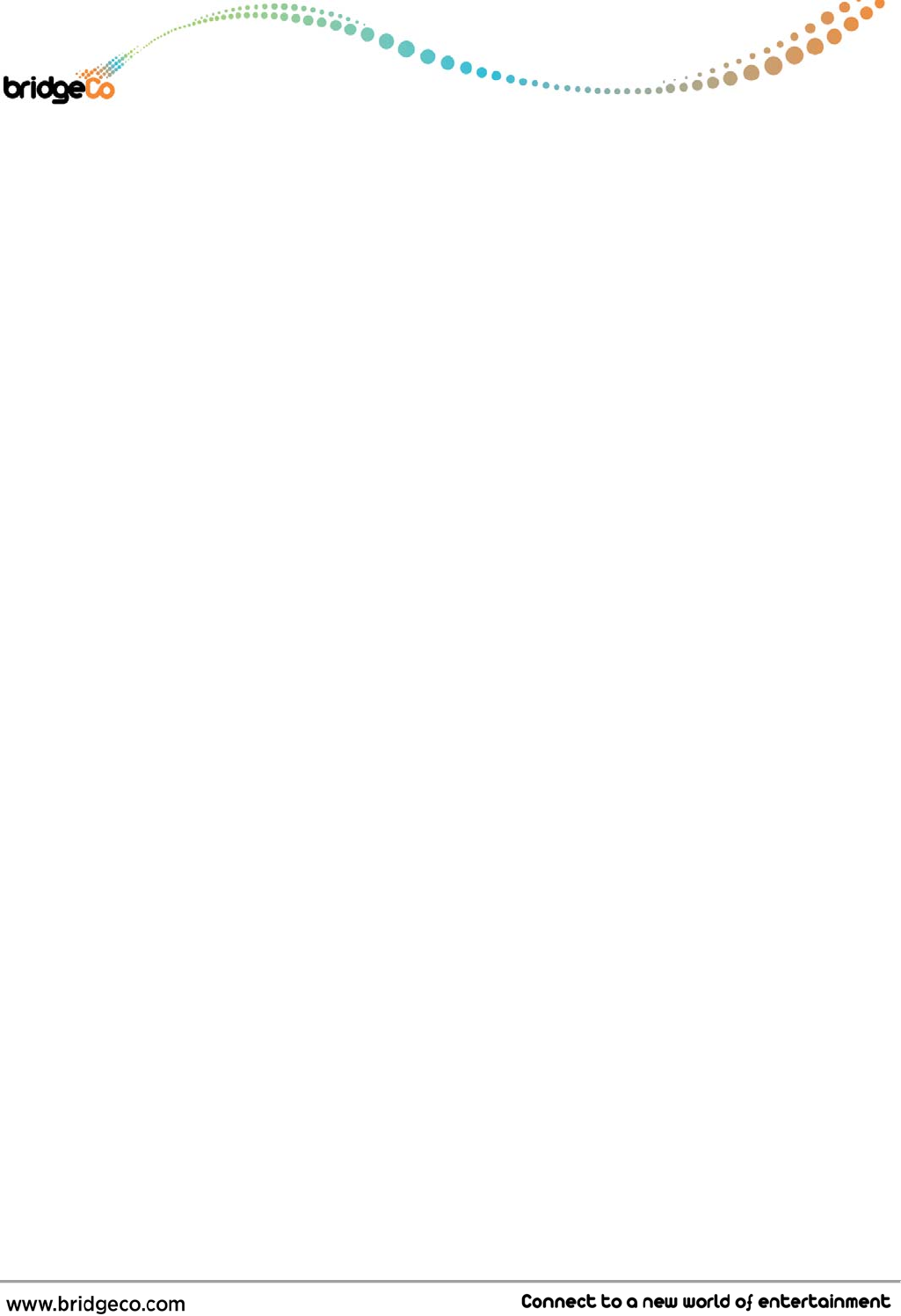
Preliminary Data Sheet: CX Series
JukeBlox Networked Media Modules
dat_CX860_CX870_1_7_datasheet_c.doc PRELIMINARY - CONFIDENTIAL Version 1.7 – May 13th 2011 - Page 2 of 23
Table of Contents
1. Introduction 4
2. Block Diagram 4
3. Board Pictures 5
3.1 Top View of CX870 5
3.2 Bottom View of CX870 5
4. Ordering Guide 6
5. Electrical Specifications 6
5.1 Absolute Maximum Ratings 7
5.2 Operating Conditions 7
5.3 WiFi Specification (CX870 only) 7
6. Regulatory Compliance and Quality 8
6.2 Environmental Test 9
6.3 ESD and Transient Test (Applies to LAN and USB external connections only) 9
6.4 Magnetic Field Test 9
6.5 MTBF 9
6.6 Mechanical Specifications 9
6.7 Module Quality 9
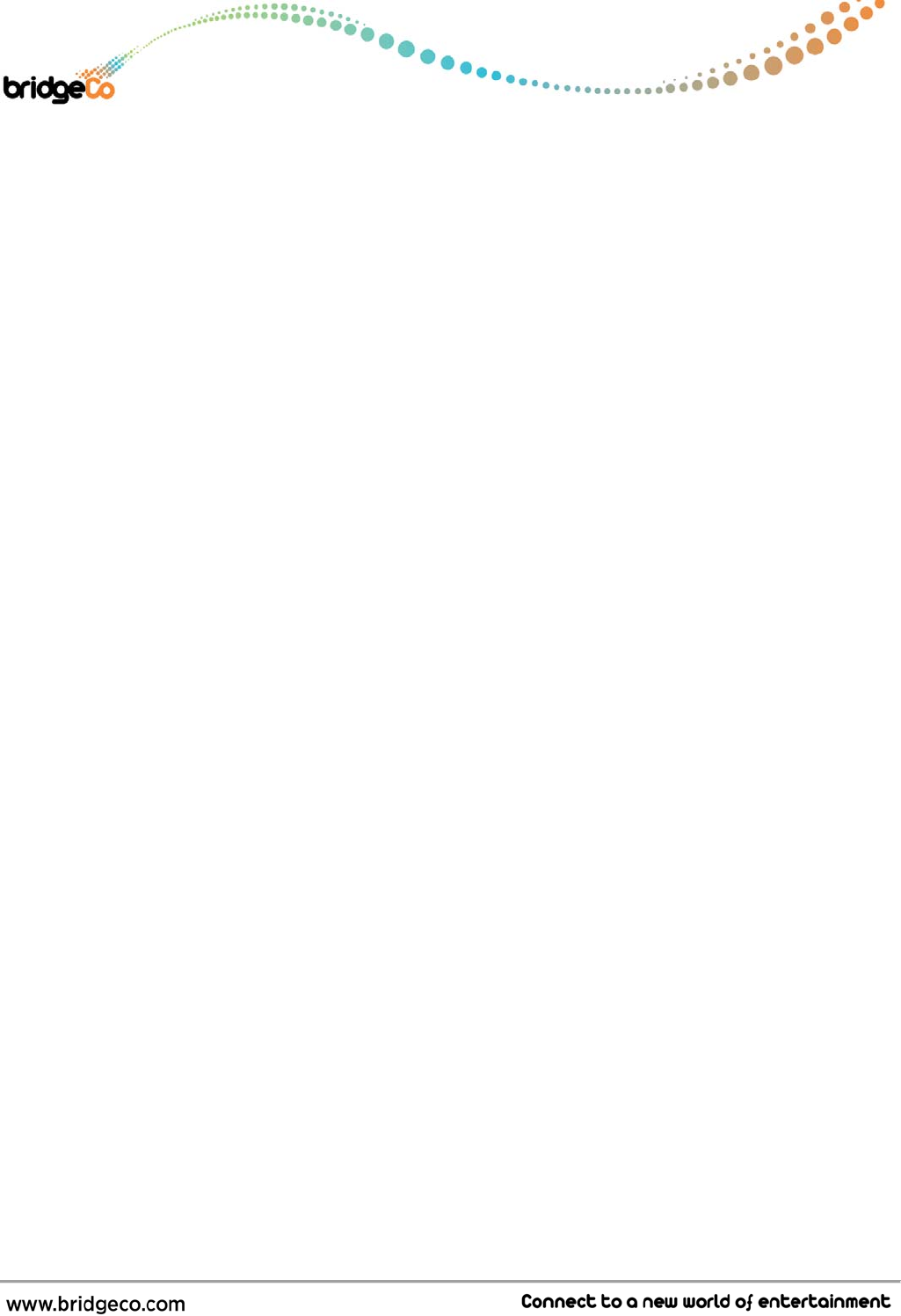
Preliminary Data Sheet: CX Series
JukeBlox Networked Media Modules
dat_CX860_CX870_1_7_datasheet_c.doc PRELIMINARY - CONFIDENTIAL Version 1.7 – May 13th 2011 - Page 3 of 23
7. Board Dimensions and Weight 10
7.1 Top & Bottom View of CX870 module 10
7.2 Side View of CX870 module 10
7.3 3D View of CX870 module 11
7.4 Module weight 11
8. Connectors and Connections 12
8.1 WLAN UFL Antenna Connector (optional) 12
8.1.1 Coaxial antenna connector dimensions 12
8.2 Module Connectors 12
8.2.1 Pin Descriptions 13
8.2.2 Connector PIN Assignments 17
8.2.3 GPIO Assignments 19
9. Application Guidelines 19
9.1 Power Supply sequencing and Reset Timing 19
9.1.1 Power up, Reset and Power Down Timing 20
9.2 RF Considerations 20
10. Revision Control 21
Module Revision History 23
Trademarks 23
Warranty Limitations 23
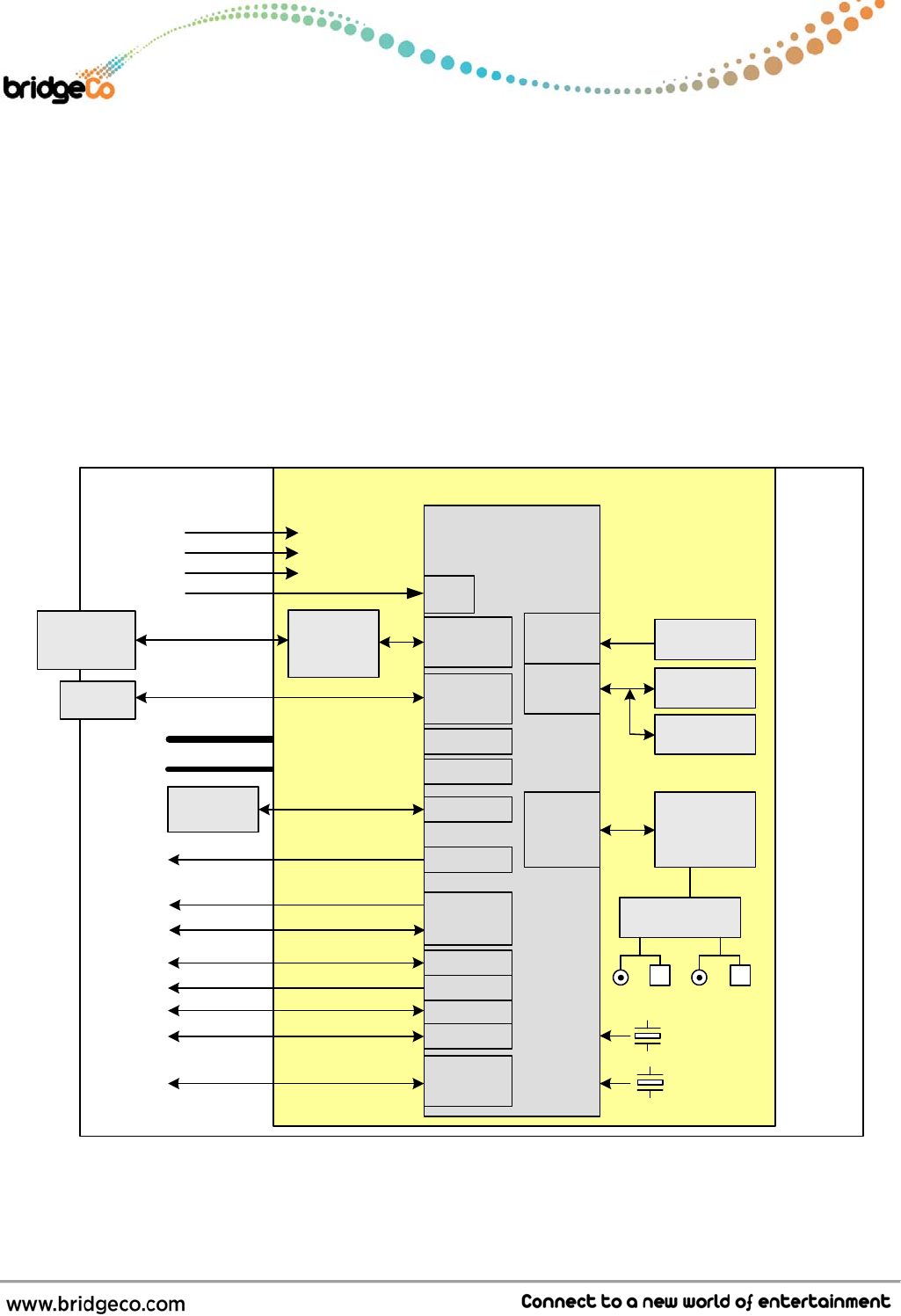
Preliminary Data Sheet: CX Series
JukeBlox Networked Media Modules
dat_CX860_CX870_1_7_datasheet_c.doc PRELIMINARY - CONFIDENTIAL Version 1.7 – May 13th 2011 - Page 4 of 23
1. Introduction
The CX-series module is a single-board networked media player module, based on BridgeCo’s DM860
and DM870 media processors, and enables fast product developments with Ethernet, USB and
optional WiFi connectivity. The module connects to standard legacy components in various audio,
video/LCD and control formats.
2. Block Diagram
Ethernet
Transceiver
DM860
or
DM870
256 Mbit
SDRAM
RJ-45
+
Transformer Mem.
Bus
USB
GPIO
24.000 MHz
NAND-Flash
2.4 GHz RF
transceiver
802.11
RMII
I2C
32.768 kHz
RTC Clock
USB
Type-A
UART
3.3V
JukeBlox Networked Media Module – CX Series
1.2V
UART
GPIO
DAC
PCB
Antenna
RF Amp. ANT
switch
Ext.
Antenna
PWM DAC
1.9V
Flash
NOR-Flash
I2C
Apple Co-
processor I2C
JTAG
I2C
JTAG
LCD
3x6bit RGB
Display
SSM
4/8bit MMC
SD-Card
RST
Reset In
Video Out
Audio I/O
A/D, D/A
S/PDIF
CCIR-656 AV
Ports
SPI
SPI Ctrl.
Host
Controller/
LCD setup
PCB
Antenna
Ext.
Antenna
Note:
Choice of antenna is a build option, see Ordering Guide.
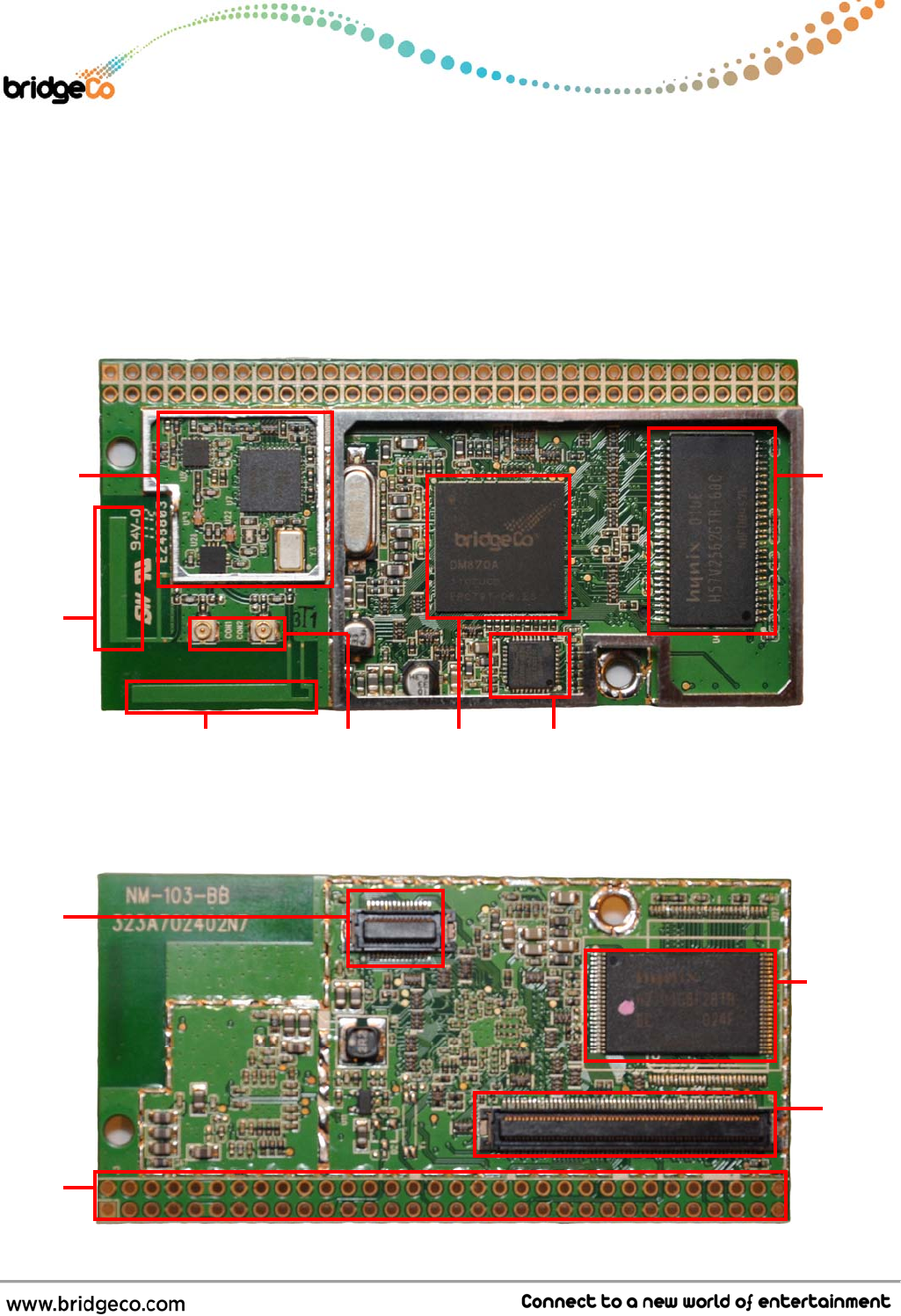
Preliminary Data Sheet: CX Series
JukeBlox Networked Media Modules
dat_CX860_CX870_1_7_datasheet_c.doc PRELIMINARY - CONFIDENTIAL Version 1.7 – May 13th 2011 - Page 5 of 23
3. Board Pictures
Please note that the below pictures show the prototype version of the layout, and do not include the RF and top shields that
will be present on production modules. Pictures of production version modules will be added as soon as possible.
Also, please note that the 64-pin connector mounted on the module is the male gender.
3.1 Top View of CX870
3.2 Bottom View of CX870
802.11b/g
front-end
PCB
antenna
External
Antenna
Connectors
BridgeCo
processor Ethernet
PHY
FLASH
Media
connector
LCD
connector
Low density
connector
SDRAM
PCB
antenna
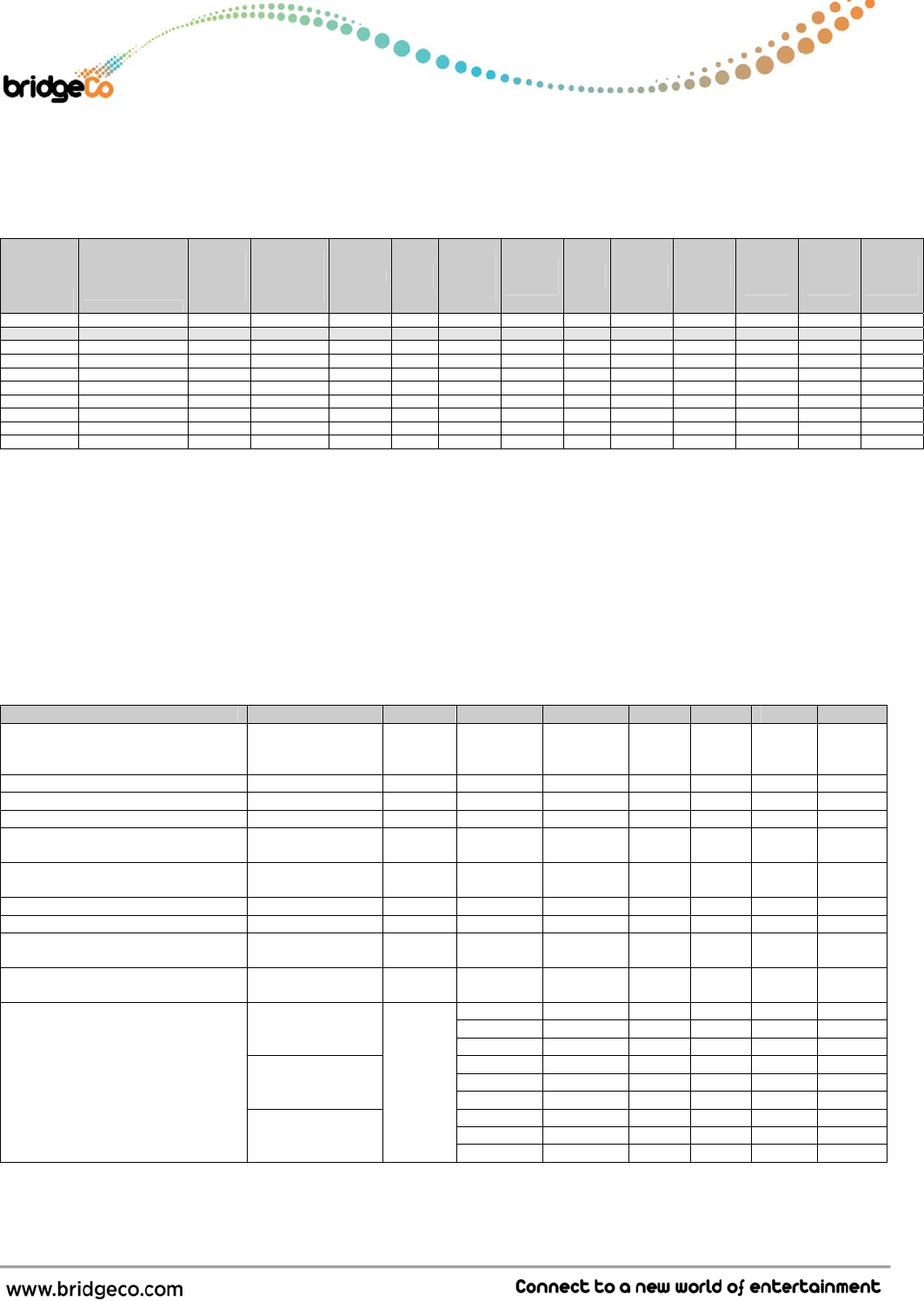
Preliminary Data Sheet: CX Series
JukeBlox Networked Media Modules
dat_CX860_CX870_1_7_datasheet_c.doc PRELIMINARY - CONFIDENTIAL Version 1.7 – May 13th 2011 - Page 6 of 23
4. Ordering Guide
Part
Number BridgeCo IC’s
WiFi (on-
module
PCB
diversity)
Ext.
Diversity
Antennas
(UFL Conn.)
Ethernet USB
Host
Low
density
64-pin
Conn.
Media
120-pin
Conn.
LCD
Conn. 32MByte
SDRAM 16MByte
SDRAM
1Gbit
NAND
FLASH
8MByte
NOR
FLASH
Top
Module
Shield
CX870-3A DM870+T6201 X (X)* X X X X X X X
CX870-3B DM870+T6201 X X X X X X X
CX870-3D DM870+T6201 X (X)* X X X X X X
CX870-3F DM870+T6201 X X X X X X X
CX870-3G DM870+T6201 X X X X X X
CX870-3H DM870+T6201 X X X X X X X
CX870-3I DM870+T6201 X X X X X X
CX870-3J DM870+T6201 X X X X X X
Note: Please note that the Apple Authentication Coprocessor will not be provided on the
CX module. The Apple Authentication Coprocessor should be provided on the product
motherboard, connected to the SDA, SCL signals from the CX module.
Note: Shaded rows indicate Custom or Obsolete configuration - NOT TO BE USED FOR
NEW/STANDARD MP DESIGNS.
* Connector on board, but requires board modification to enable the connector
5. Electrical Specifications
Parameter State Model Voltage Symbol min. typ. max. Units
Power Supply Input Voltage
VIN 3.0
1.08
1.8
3.3
1.2
1.9
3.6
1.32
2.0
V
V
V
Logic Input high voltage VIH 1.7 5.5 V
Logic Input low voltage VIL -0.3 0.7 V
Logic Input threshold voltage VIT 1.29 1.39 1.5 V
Schmitt-trigger input low to
high threshold voltage VIT+ 1.58 1.65 1.71 V
Schmitt-trigger input high to
low threshold voltage VIT- 0.95 1.01 1.06 V
Logic Output high voltage VOH 2.4 V
Logic Output low voltage VOL 0.4 V
Logic Low-level output current
(VOL=0.4V) IOL -9.6 -15.6 -19.3 mA
Logic High-level output current
(VOH=2.4V) IOH 11.1 22.5 35.3 mA
3.3 I3.3 60 78 mA
1.2 I1.2 32 42 mA
Reset State
1.9 I1.9 18 23 mA
3.3 I3.3 185 241 mA
1.2 I1.2 337 438 mA
Operating in idle
state 1.9 I1.9 257 334 mA
3.3 I3.3 240 312 mA
1.2 I1.2 347 451 mA
Current Consumption
Playback over
WiFi high mips
& rate condition
CX870
1.9 I1.9 258 335 mA
Note: The maximum current values are 30% larger than the typical values. The
maximum values are intended to be used for power supply sizing calculations.
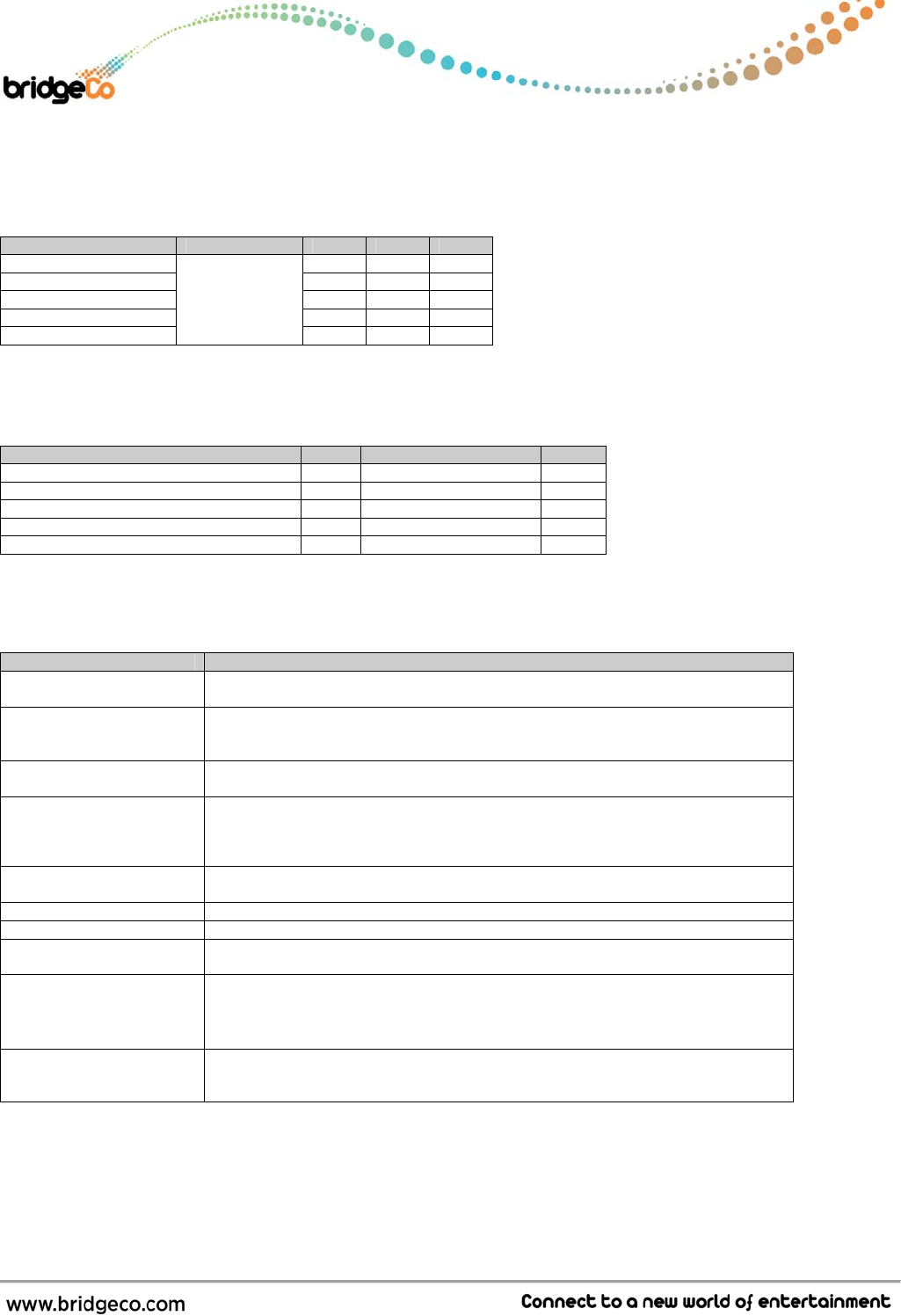
Preliminary Data Sheet: CX Series
JukeBlox Networked Media Modules
dat_CX860_CX870_1_7_datasheet_c.doc PRELIMINARY - CONFIDENTIAL Version 1.7 – May 13th 2011 - Page 7 of 23
5.1 Absolute Maximum Ratings
Parameter Component Min Max Units
3.3V Supply Voltage -0.5 4.6 V
1.2V Supply Voltage -0.5 1.8 V
1.9V Supply Voltage -0.5 2.2 V
Logic Input Voltage -0.5 6 V
Logic Output Voltage
Main
-0.5 4.6 V
5.2 Operating Conditions
Parameter Min Max Units
Operating Temperature 0 +70 °C
Operating Humidity 10 90 (non condensing) %RH
Storage Temperature -10 +75 °C
Storage Humidity 10 95 (non condensing) %RH
Storage Temperature Cycle Test 24 hrs -10 +75 °C
5.3 WiFi Specification (CX870 only)
Feature Description
WLAN Standards IEEE 802.11b
IEEE 802.11g
Frequency Band 2.412 – 2.472 GHz (2.4GHz ISM Band, 13 Channels)
Channel 1 - Channel 13
North America, Japan Telec, Europe ETSI
Modulation 802.11b mode (DS-SS: IEEE 802.11b)
802.11g mode (OFDM: IEEE 802.11g)
Transmission Speed 802.11b mode
11Mbps, 5.5Mbps, 1Mbps
802.11g mode
54Mbps, 48Mbps, 36Mbps, 24Mbps, 18Mbps, 12Mbps, 9Mbps, 6Mbps
Tx Power 802.11b mode (16.5dBm, +/-1dBm)
802.11g mode (21dBm, +/-1dBm)
Power-on Ramp < 2us
RF Carrier Suppression < 15dBc
TX EVM < -5dB @ 6Mbps
< -25dB @ 54Mbps
Rx Sensitivity
(incl. CE2 Mother board) 802.11b mode
=<-88dBm @ 1Mbps, =<-85dBm @ 5.5Mbps, =<-83dBm @ 11Mbps
802.11g mode
=<-86dBm @ 6Mbps, =<-75dBm @ 36Mbps, =<-69dBm @ 54Mbps
Throughput Rate
(measured for each
module)
See factory test specification
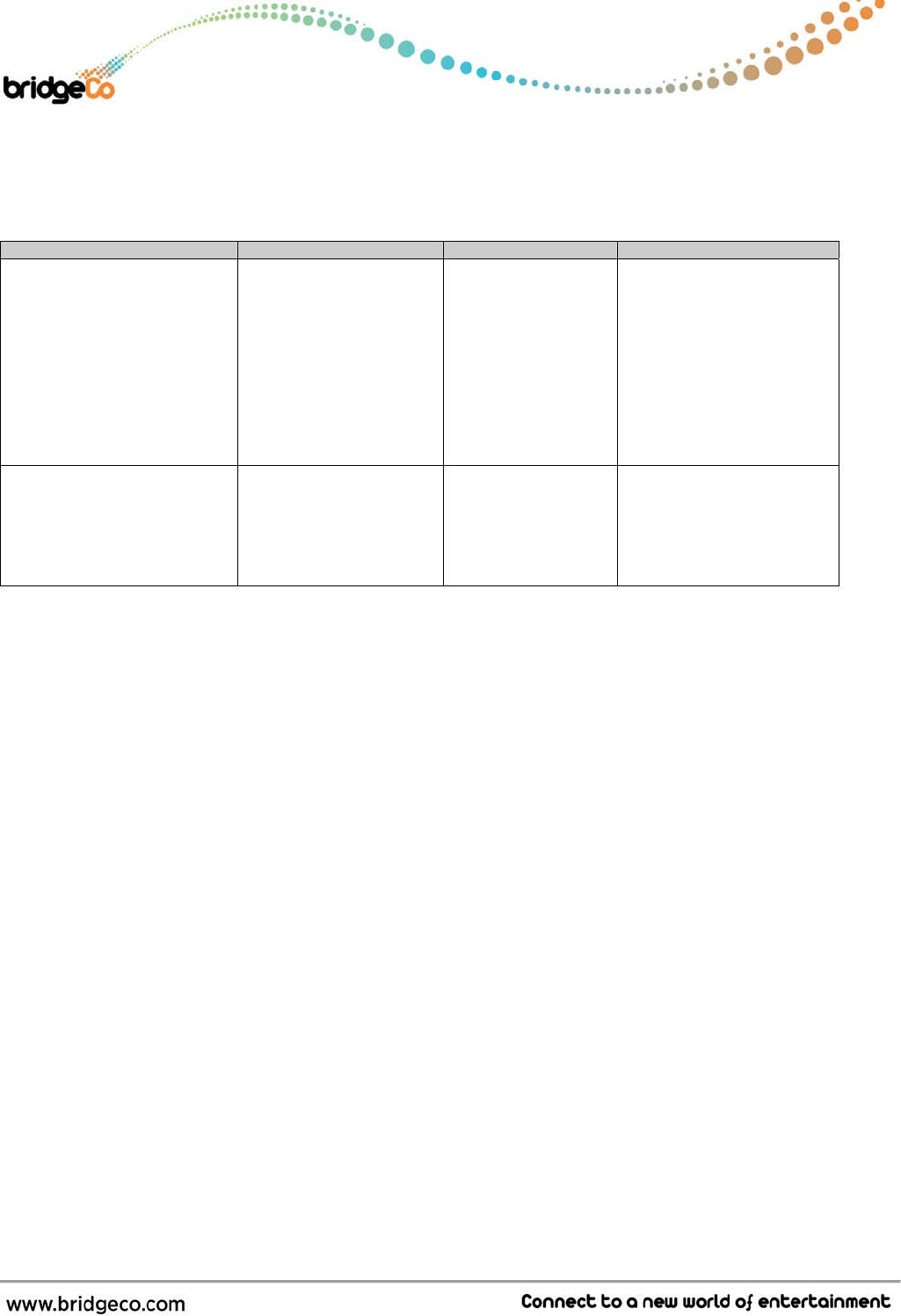
Preliminary Data Sheet: CX Series
JukeBlox Networked Media Modules
dat_CX860_CX870_1_7_datasheet_c.doc PRELIMINARY - CONFIDENTIAL Version 1.7 – May 13th 2011 - Page 8 of 23
6. Regulatory Compliance and Quality
Description Country Compliance Module Versions Passed
Electromagnetic Compatibility
(Prescan) USA
Europe FCC CFR47 Part15B
EN 55022
EN 55024
EN 61000-3-2
EN 61000-3-3
EN 61000-4-2
EN 61000-4-3
EN 61000-4-4
EN 61000-4-5
EN 61000-4-6
EN 61000-4-8
EN 61000-4-11
Radio Regulations (CX870
only) USA
Japan
Canada
Europe
New Zealand/Australia
China
Korea
FCC Part 15C
Telec
IC RSS-210
CE
CE
SRRC
KCC
tbd
tbd
tbd
tbd
tbd
tbd
tbd
Note: BridgeCo does not certify all module variants for all countries.
Please contact your BridgeCo sales office for the latest information about which modules
are certified for which countries, and arranging for additional certification for
your chosen module if needed. Product manufacturers are responsible for the end
product certification.
BridgeCo can help manufacturers to prepare for the WiFi Alliance tests by providing an
example test plan and the required commands to enable special test modes. Please
contact your BridgeCo sales office about WiFi Alliance logo certification assistance.
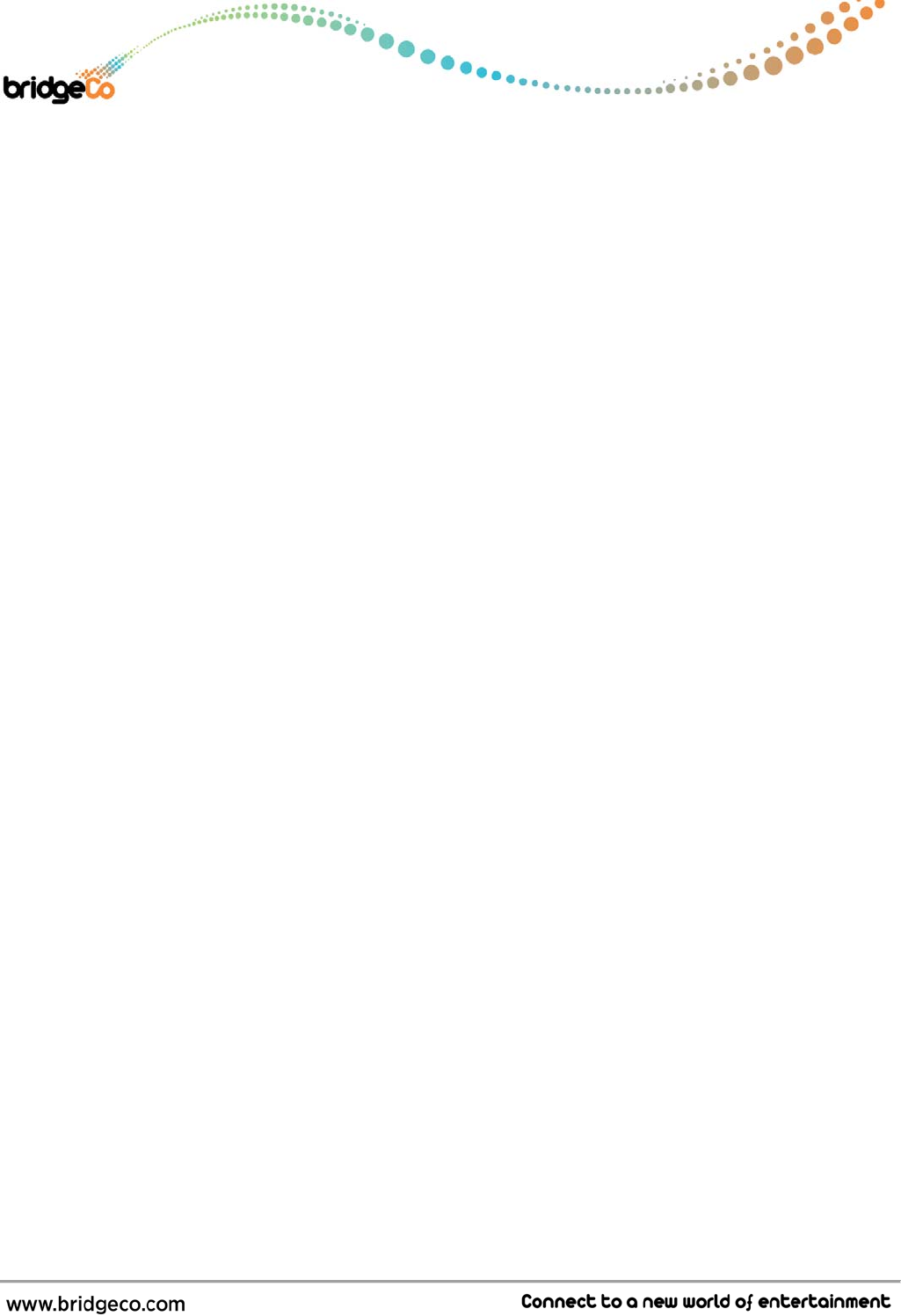
Preliminary Data Sheet: CX Series
JukeBlox Networked Media Modules
dat_CX860_CX870_1_7_datasheet_c.doc PRELIMINARY - CONFIDENTIAL Version 1.7 – May 13th 2011 - Page 9 of 23
6.1 RoHS
Uses only RoHS compliant components
6.2 Environmental Test
Withstands 4 hours at 70°C, 90% RH
6.3 ESD and Transient Test (Applies to LAN and USB external connections
only)
ESD: +/- 2kV operation, +/- 4kV no destruction (part of CE test)
Fast electrical transients: +/- 500V operation, +/- 1000V no destruction (part of CE test)
6.4 Magnetic Field Test
Passes EN55022 and EN55024 (part of CE test)
6.5 MTBF
>10000 hours
6.6 Mechanical Specifications
Passes drop test according to I.E.C. 68-2-32, height 100 cm, 1 corner, 6 faces.
Passes vibration test with sine, vertical, 60 minutes, 600 to 18000 cpm, 1G
6.7 Module Quality
Defect Rate: TBD
AQL CR=0, MA=0.4, MI=0.4
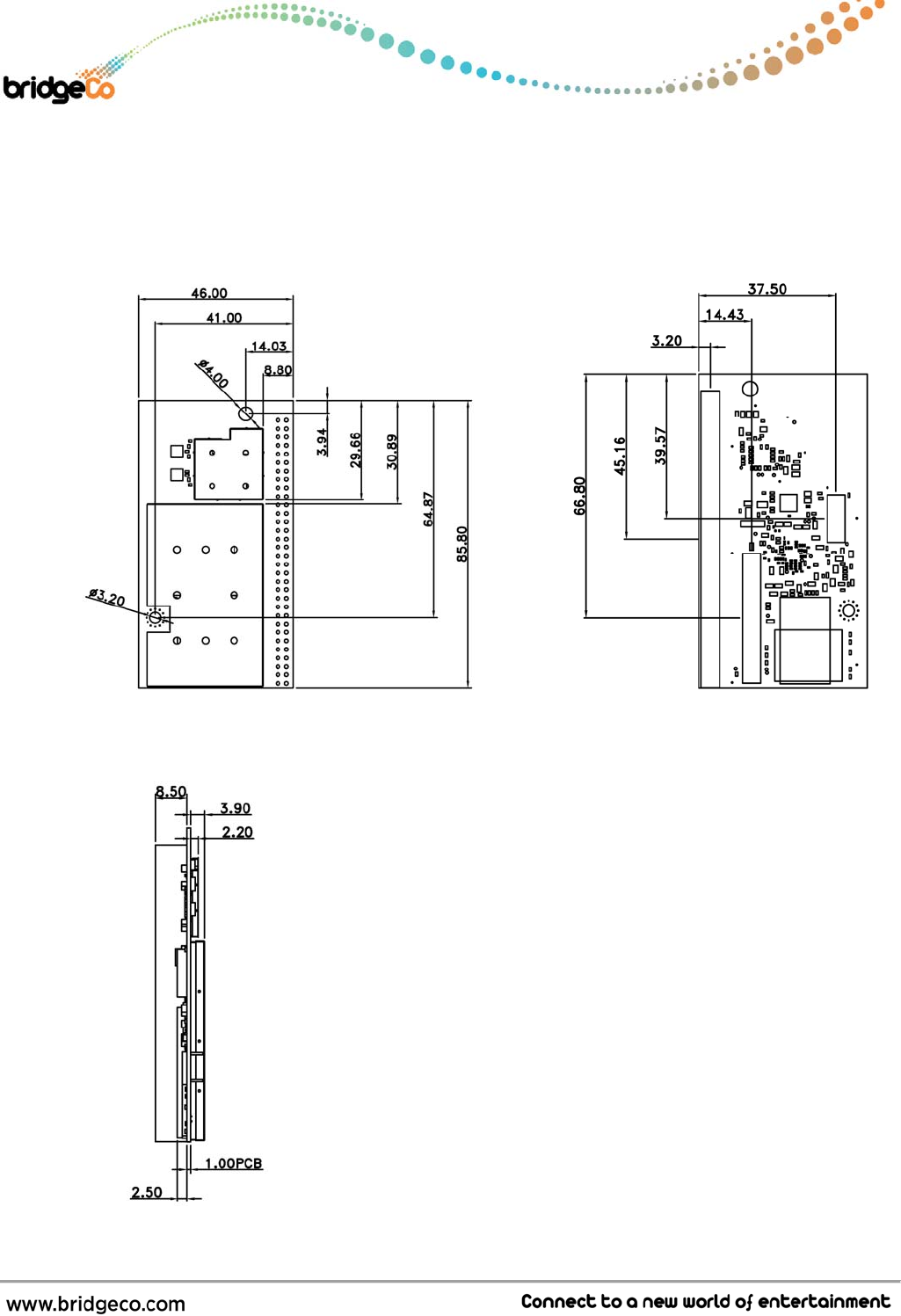
Preliminary Data Sheet: CX Series
JukeBlox Networked Media Modules
dat_CX860_CX870_1_7_datasheet_c.doc PRELIMINARY - CONFIDENTIAL Version 1.7 – May 13th 2011 - Page 10 of 23
7. Board Dimensions and Weight
7.1 Top & Bottom View of CX870 module
7.2 Side View of CX870 module
Note:
1. All dimensions are measured in millimetres (mm).
2. PCB’s thickness: 1.00 +/- 0.10mm
3. Tolerance: +/-0.10mm
4. Outline Tolerance: +/-0.10mm
5. NPTH Hole: +/-0.05mm
6. PTH Hole: +/-0.075mm
7. Connector positions, board dimensions, mounting
hole positions and sizes are the same for all module
variants.
8. Connector position tolerance: +/- 0.38mm
9. The 64-pin connector mounted on the module along
one edge is the male gender.
10. Not all module variants have all connectors. Please
see the Ordering Guide table for details of connector
options.
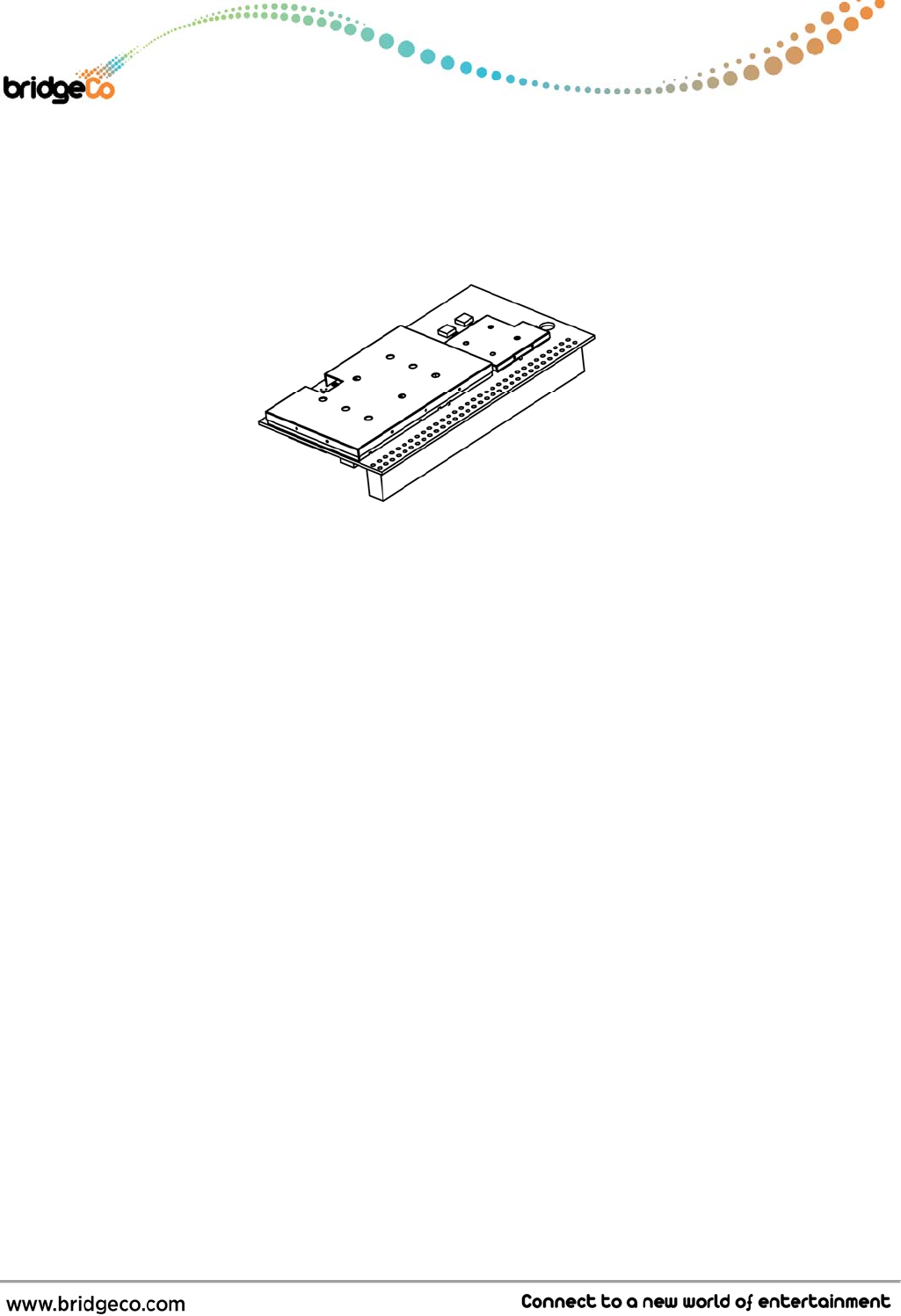
Preliminary Data Sheet: CX Series
JukeBlox Networked Media Modules
dat_CX860_CX870_1_7_datasheet_c.doc PRELIMINARY - CONFIDENTIAL Version 1.7 – May 13th 2011 - Page 11 of 23
7.3 3D View of CX870 module
7.4 Module weight
CX860: 14g
CX870: 15g
Note: Module weight applies to all versions of the module.

Preliminary Data Sheet: CX Series
JukeBlox Networked Media Modules
dat_CX860_CX870_1_7_datasheet_c.doc PRELIMINARY - CONFIDENTIAL Version 1.7 – May 13th 2011 - Page 12 of 23
8. Connectors and Connections
8.1 WLAN UFL Antenna Connector (optional)
The module includes two PCB strip antennas operated in diversity mode. Alternatively, two coaxial
antenna connectors are provided for connecting external (to the module) antennas. The choice
between using the strip antenna or using the coaxial sockets is a build option, determined by the
position of surface mount capacitors on the module PCB. If the PCB antennas are chosen, then
diversity mode is always used. If external (to the module) antenna sockets are used, then either one
or two external antennae may be connected. Using two antennae is preferred since this provides 2X
diversity operation. Please see ordering guide for build option details.
The surface-mount receptacle parts:
Hirose
U.FL-R-SMT (CL No. 331-0471-0)
8.1.1 Coaxial antenna connector dimensions
8.2 Module Connectors
The CX860/870 module uses 3 board-to-board connectors as interfaces to the product main board.
The part numbers for the connectors needed on the product main board, which mate with the
connectors on the CX module, are shown in the table below.
Connector
Number Connector
Purpose Connector
Type Number
of Pins Pin
Configuration Mating Connector Part
Numbers
J1 LCD 30 2 x 15 x 0.5mm 14-5046-030-145-829+ (Kyocera)
J2 Media 120 2 x 60 x 0.5mm 14-5046-120-145-829+ (Kyocera)
J3 Low Density
B2B
Connector 64 2 x 32 x 2.54mm CSHA201-3202A001A1AB
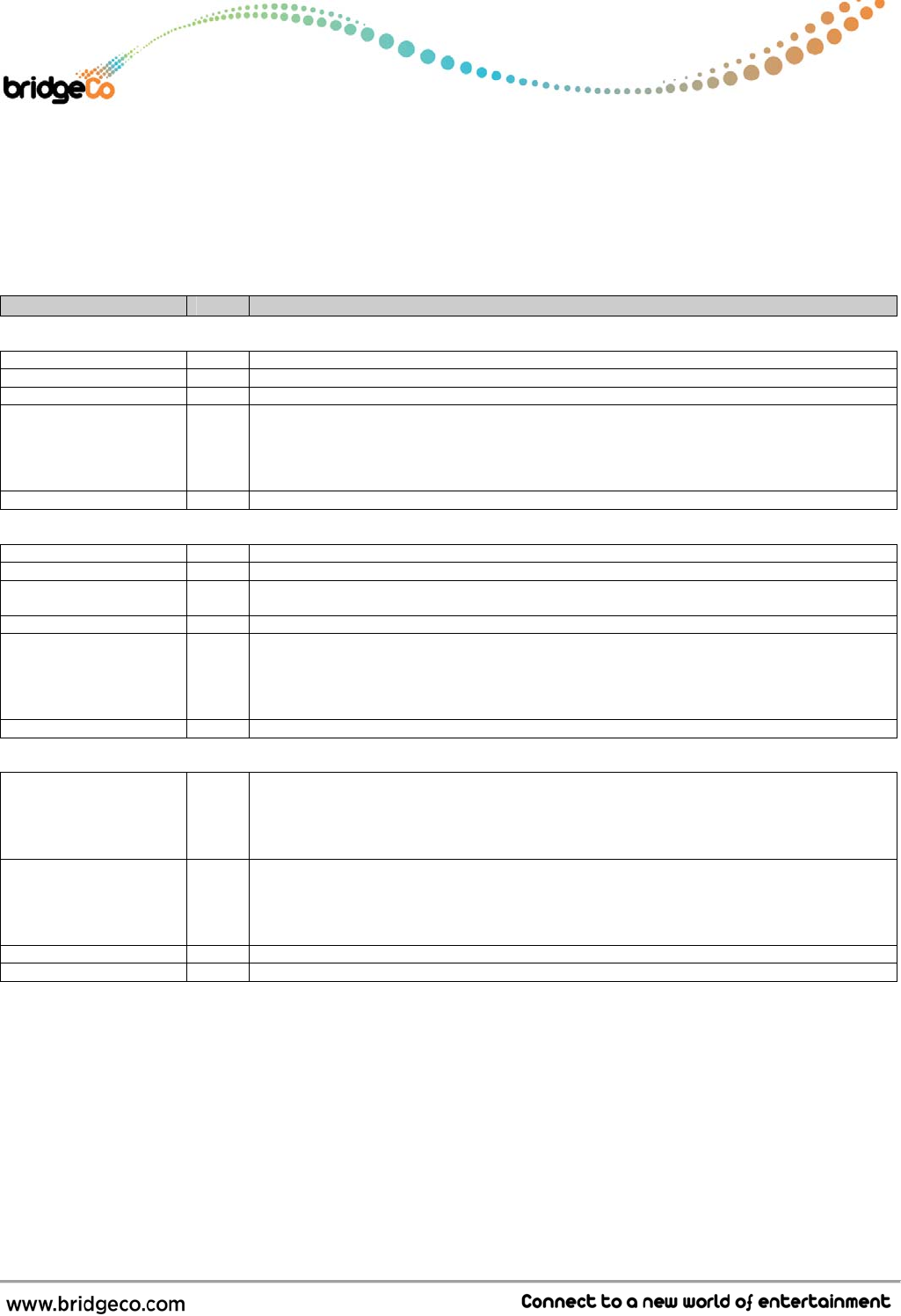
Preliminary Data Sheet: CX Series
JukeBlox Networked Media Modules
dat_CX860_CX870_1_7_datasheet_c.doc PRELIMINARY - CONFIDENTIAL Version 1.7 – May 13th 2011 - Page 13 of 23
The pinout and signal names are shown on the next page. The following table provides an overview
for the most important control and interface signals.
8.2.1 Pin Descriptions
Signal(s) Type Description
POWER
VIN(+3.3V) P Power supply input ; +3.3V.
VIN (+1.2V) P Power supply input ; +1.2V.
VIN (+1.9V) P Power Supply input; +1.9V for powering RF section. Make sure this is a clean supply.
3V3RTC P For module versions without Real Time Clock (RTC) option, and for module versions with
RTC option where the RTC function is not used, this pin should be left open. For module
versions with RTC option, and the RTC function is used, then this pin should be connected
to the positive terminal of a 1F capacitor connected to GND. This capacitor will power the
RTC circuits in the DM870 IC when the module power supply is switched off.
GND P Ground (GND) connection for power supply 0V, signal returns and shielding.
SPI
SPI_DOUT O SPI data from DM870 to host controller.
SPI_DIN I SPI data from host controller to DM870.
SPI_CLK I SPI clock from host controller to DM870. Maximum recommended frequency is 2MHz,
typical frequency is 1MHz. See Note 2 below.
SPI_NCS0 I SPI chip select from host controller to DM870.
PDOUT1 O This signal is used as SPI_REQ, SPI request signal, from DM870 to host controller for
eDMP applications. Logic 1 indicates that there is an SPI message waiting to be read,
the host controller should start the SPI clock and read any changed registers. Logic 0
indicates that all changed register messages have been read and the message buffer is
empty. Also GPIO-06.
SPI_NCS1 I Not used. Leave open.
UART
RXD1 I UART1 input to the DM870, used for shell access. BridgeCo recommends providing a
connection to an external RS-232 transceiver and DB9 connector to connect to a PC COM
port. Such a connection can be used for product development debugging, and for module
programming control on the product manufacturing line and for module control during
certification procedures.
TXD1 O UART1 output from the DM870, used for shell access. BridgeCo recommends providing a
connection to an external RS-232 transceiver and DB9 connector to connect to a PC COM
port. Such a connection can be used for product development debugging, and for module
programming control on the product manufacturing line and for module control during
certification procedures.
RXD0 I UART0 input. Optionally used for controlling an iPod via UART.
TXD0 O UART0 output. Optionally used for controlling an iPod via UART.
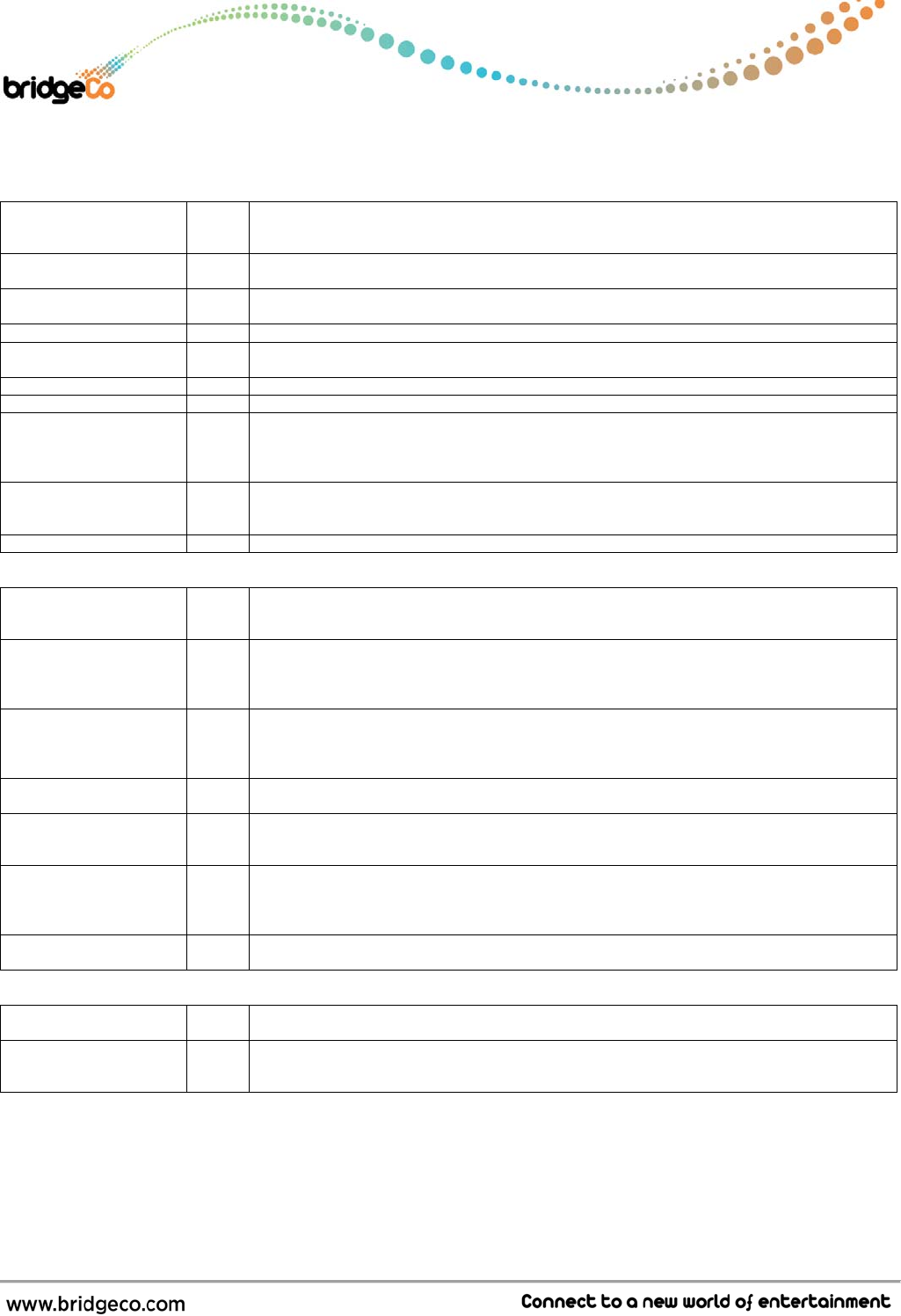
Preliminary Data Sheet: CX Series
JukeBlox Networked Media Modules
dat_CX860_CX870_1_7_datasheet_c.doc PRELIMINARY - CONFIDENTIAL Version 1.7 – May 13th 2011 - Page 14 of 23
AUDIO
AV2DATA0 O I2S or left justified audio data output. Typically connected to external D/A converter
input or to external DSP for further audio processing. Used for main left and right
channel audio output data. See Note 3.
AV2CTRL0 O LRCK, audio data word clock at the audio sample rate (Fs). Maximum currently
supported frequency is 192kHz.
AV2CTRL1 O MCLK, audio master clock at 256Fs. This can be used to clock an external D/A converter
or DSP.
AV2CLK O SCLK, audio data bit clock at 64Fs. Allows for up to 32 audio data bits per sample word.
AV4DATA1 O SPDIF format output. Can support samples rates up to 192kHz, so the maximum
instantaneous frequency on this pin is 24.576MHz.
AV4DATA0 I SPDIF input. Not used at present. Leave open.
AV2DATA1 O I2S or left justified audio data output. Not used at present. Leave open.
AOUTLP/AOUTLN,
AOUTRP/AOUTRN O Differential stereo output from PWM-DAC, right and left channels. These signals require
analog low pass filtering. BridgeCo is not recommending using the PWM-DAC outputs
because of the potential for high out-of-band noise and uncharacterized audio quality.
BridgeCo recommends using an external D/A converter connected to AV2DATA0.
AV2DATA2 I I2S or left justified audio data input. Can be driven from an optional external A/D
converter used to interface to iPod analog output or other analog audio sources. If not
used, leave open.
AV2DATA3 I I2S or left justified audio data input. Not used at present. Leave open.
CONTROL
NCS3 I BIST activate. Low-active input to invoke the Built In Self Test (BIST) function. This
only applies to factory fresh modules. After JB2 firmware is loaded, this signal becomes
GPIO-17 and is currently not used. DM870-internal pull-up. Leave this pin open.
PDOUT0 I Factory Reset. GPIO-04. Return the CnE to factory settings. High-active input, DM870-
internal pull-down. Pull to GND with a 10kohm resistor, unless return to factory settings
from a hardware control is needed. Normally, return to factory settings is controlled from
the host controller via SPI register. This pin is only monitored during the boot up process.
VCO0 I Infrared sensor input. GPIO-05. This is a Schmitt-Trigger input and can handle inputs
with slow slopes. Used for aDMP firmware builds for infrared remote control sensor
output connection to DM870. For applications with a host controller, pull this pin to +3.3V
via a 10kohm resistor.
AV3CLK O ETH_NRESET Low-active reset for the on-board ethernet PHY. This output is driven by
the DM870. GPIO-12. Leave this pin open.
AV3CTRL0, AV3CTRL1 I/O I2C_SCL, I2C_SDA bus created by GPIO-13 and GPIO-14.
No internal pull-ups; Use 4.7kohm pull up resistor on each pin to +3.3V. Maximum
frequency is 400kHz.
NRESET_MOD I Low-active input to reset the module. This signal must be driven by an external reset
generator, or by a GPIO output from a host controller. See the application section of this
data sheet for the timing requirements for NRESET_MOD. Includes internal 10K pull-up
resistor to +3.3V.
NPD_RF I Active low input to shut down the power for the 802.11 RF section. Internal 10kohm
pull-up resistor to +3.3V. Leave open if powering down the RF section is not required.
ETHERNET
ETH_RXN, ETH_RXP,
ETH_TXN, ETH_TXP M Ethernet signals between the PHY on the module and the external magnetics
(transformer). See Note 4. Maximum bit rate is 100Mbps.
ETH_LED_SPEED,
ETH_LED_ACT O
3.3V push-pull outputs (max. ±12mA) to drive the ethernet LEDs.
100Mbps speed mode and activity are indicated by the outputs being low. Connect to
LEDs through 220ohm resistors.
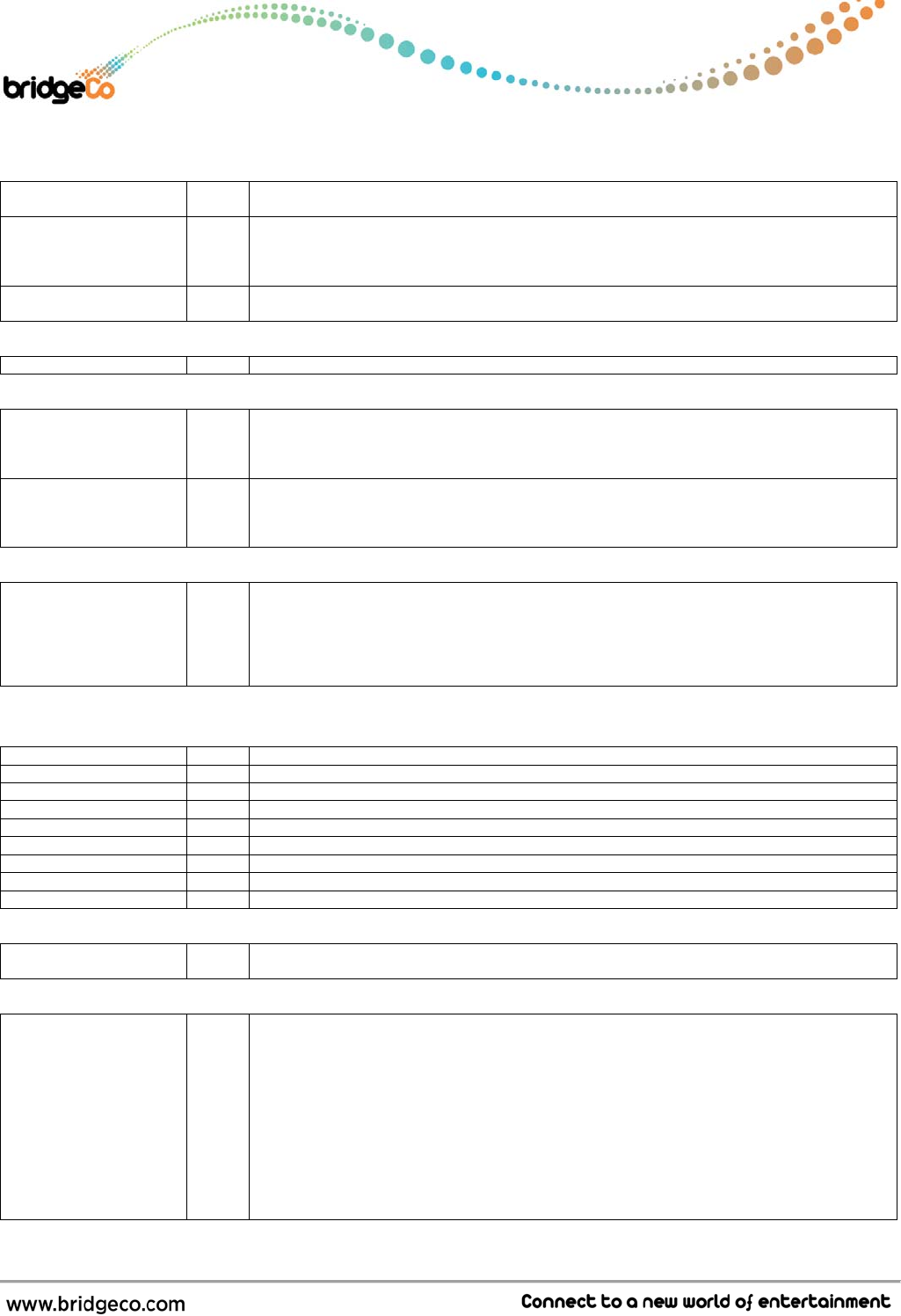
Preliminary Data Sheet: CX Series
JukeBlox Networked Media Modules
dat_CX860_CX870_1_7_datasheet_c.doc PRELIMINARY - CONFIDENTIAL Version 1.7 – May 13th 2011 - Page 15 of 23
USB
USB_DN, USB_DP M USB data signals, normally connected to type A connector, USB switch or iPod dock
connector. Maximum bit rate is USB High Speed at 480Mbps.
USB_VBUS M Analog input for monitoring USB type A connector power. Connect to the +5V power
which is driving the USB type A connector power pins. If this pin drops below 4.6V, then
the DM870 will drive the USBVBUSDRV signal low to control an external power MOSFET
to disconnect +5V power from the USB type A connector. See Note 5.
USBVBUSDRV O Logic output to control an external MOSFET that is in series with USB type A connector
power. See USB_VBUS above and Note 5.
JTAG
TMS,TCK,TDI, TDO I/O JTAG port for DM870. Leave open.
SSM
SSMD4, SSMD5,
SSMD6, SSMD7 I/O Can be used to drive external shift registers to make extended GPIO signals (see Note 6),
or as individual GPIO signals, or to make an SD card interface. SD card firmware is not
supported at present in JB2. Can be mapped to GPIO #s 08,09,10,11. Leave open if not
used.
SSMD0, SSMD1,
SSMD2, SSMD3,
SSMCLK, SSMCP,
SSMCMD, SSMWP
I/O Used to make an SD card interface. SD card firmware is not supported at present in JB2.
Leave open.
VIDEO
AV0CLK, AV0CTRL0,
AV0CTRL1, AV0CTRL2,
AV0DATA0, AV0DATA1,
AV0DATA2, AV0DATA3,
AV1DATA0, AV1DATA1,
AV1DATA2, AV1DATA3
O ITU-R BT.656 digital video output signals. Optionally used to make a TVout menu display,
or to display decoded album art. Can be connected to video D/A converter (see Note 7),
or connected to a video DSP.
GPIO (not already
mentioned elsewhere in
this table)
A22 O GPIO18 Reserved for NOR flash address A22. Leave open.
A23 O GPIO-16 Reserved for NOR flash address A23. Leave open.
NWAIT I/O GPIO-15 Not currently assigned. Leave open.
NCS2 I GPIO-19 Assigned to iPod dock connector iPod NDETECT. See Note 8.
VCO1 I/O GPIO-07 Not currently assigned. Leave open.
MMIICRS I/O GPIO-00 Not currently assigned. Leave open.
MIICOL I/O GPIO-01 Not currently assigned. Leave open.
MIITXER I/O GPIO-02 Not currently assigned. Leave open.
MIITXCLK I/O GPIO-03 iPod dock connector Accessory Power signal. See Note 8.
MII
MIITXD0, MIITXD1,
MIIRXD0, MIIRXD1 I/O Can be used, with GPIO signals above, to drive an external ethernet PHY. This is not
supported by JB2 firmware. Leave open.
LCD
LCDD0, LCDD1,
LCDD2, LCDD3,
LCDD4, LCDD5,
LCDD6, LCDD7,
LCDD8, LCDD9,
LCDD10, LCDD11,
LCDD12, LCDD13,
LCDD14, LCDD15,
LCD16, LCDD17,
LCDCLK, LCDCTRL0,
LCDCTRL1, LCDCTRL2,
LCDCTRL3
O Uses optional J1 LCD connector. Connect to local LCD display. See Note 9. Leave open if
not used.
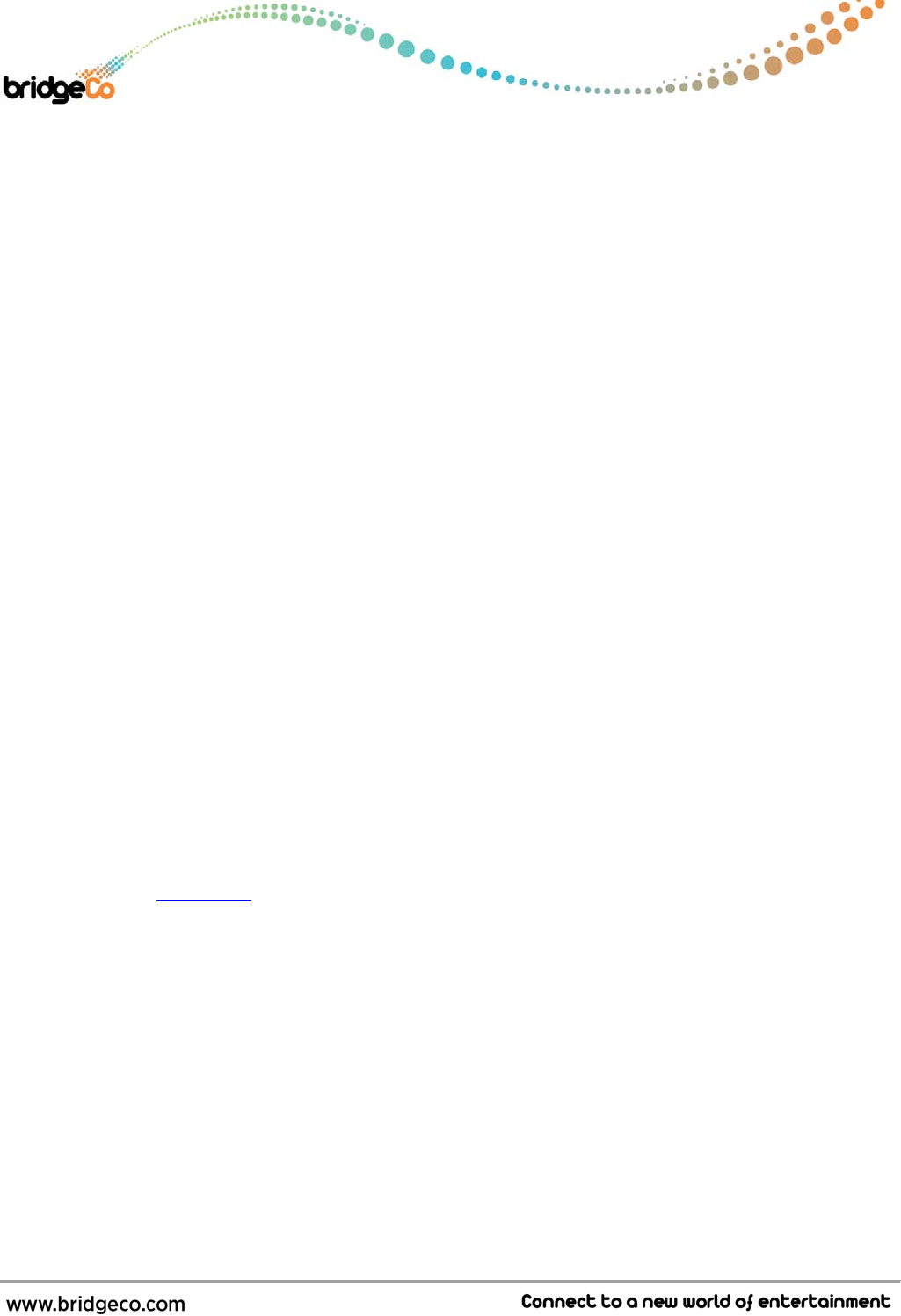
Preliminary Data Sheet: CX Series
JukeBlox Networked Media Modules
dat_CX860_CX870_1_7_datasheet_c.doc PRELIMINARY - CONFIDENTIAL Version 1.7 – May 13th 2011 - Page 16 of 23
Notes:
1. Signal type codes:
I – 3.3V level Digital Logic Input into the DM870
O – 3.3V level Digital Logic Output from the DM870
IO – 3.3V level Digital Logic Input and Output (bi-directional) signal
M – Miscellaneous, see text for description
P – Power Supply
2. For SPI timing diagram for eDMP applications, please see:
BridgeCo_JB2x - DeviceControlProtocol_Registers_v_2_1.pdf, or later version.
For detailed setup and hold timing details, see DM870 IC data sheet:
dat_DM870_16_datasheet.pdf, or later version.
3. For audio port timing diagrams, and for detailed setup and hold timing, please see DM870 IC data sheet:
dat_DM870_16_datasheet.pdf, or later version.
4. For example ethernet external schematic, see:
CX Module Ethernet (RJ45 + Ext.Magnetics)_V1.2.pdf, or later version.
5. For example USB schematics, see:
CX Module USB_V1.2.pdf, or later version.
6. For example use of extended GPIO shift registers, see CE2 schematic:
A EVMCE2-4_schematic.pdf, or later version.
7. For example connection to a video D/A converter, see CE2 schematic:
A EVMCE2-4_schematic.pdf, or later version.
8. iPod dock connector pin and GPIO assignments are under discussion. Please contact BridgeCo for
recommendations for iPod dock connections to CX870 module.
9. For example connection to an LCD display, see CE2 schematic:
A EVMCE2-4_schematic.pdf, or later version.
10. All the above signals are brought out to J2 pins. Not all the above signals are brought out to J3, the 64-pin low
density connector. The J3 pin assignments table shows which signals are brought out to the J3 pins.
11. BridgeCo has a set of example motherboard schematics that shows example external circuitry that is typically
connected to the module. Please check the BridgeCo customer portal for a copy of these example schematics.
12. Please check the BridgeCo Customer Portal Download area for the latest version of the BridgeCo documents.
Go to bridgeco.com, click on Client Login button. If you do not have an account, please contact BridgeCo.
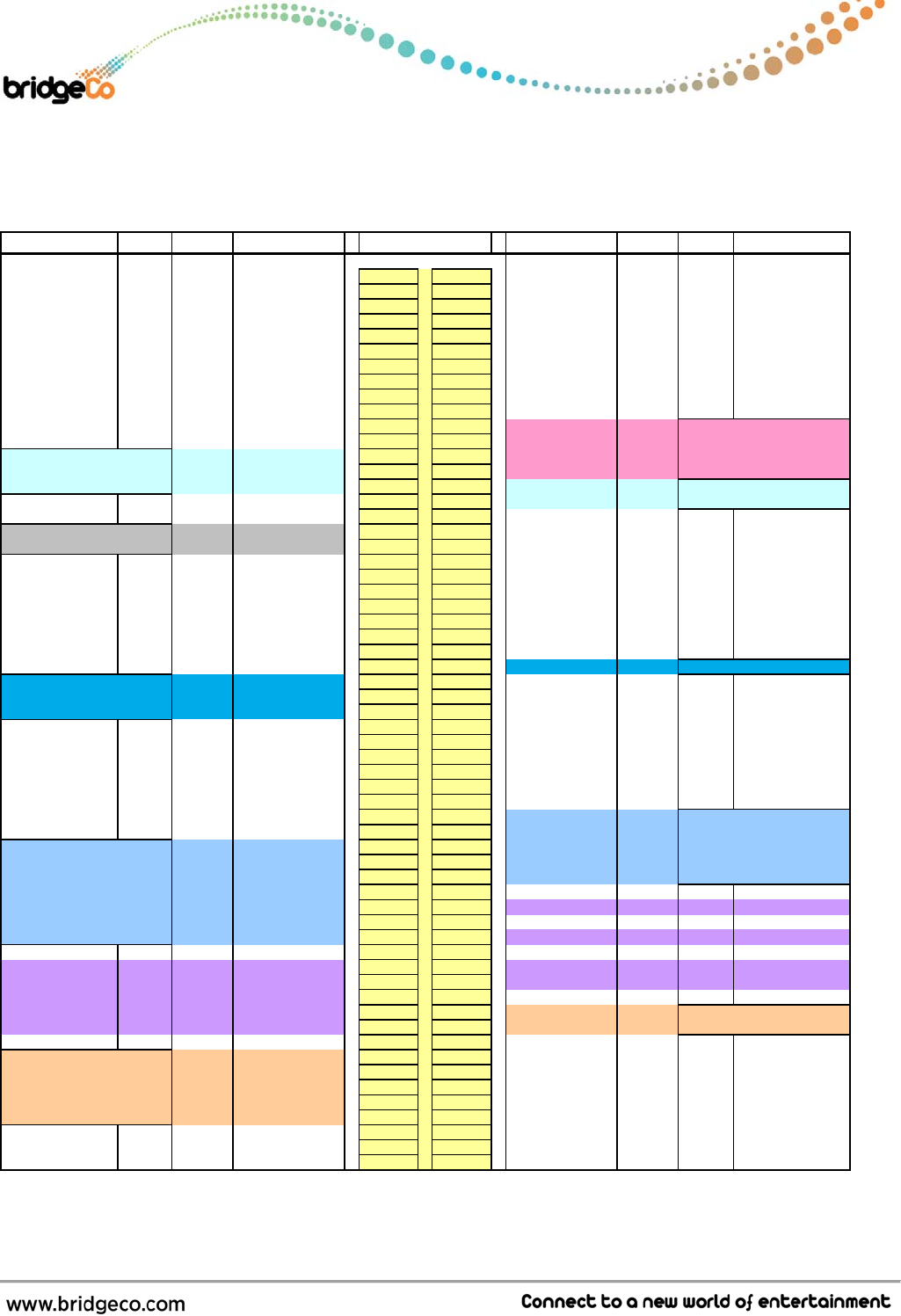
Preliminary Data Sheet: CX Series
JukeBlox Networked Media Modules
dat_CX860_CX870_1_7_datasheet_c.doc PRELIMINARY - CONFIDENTIAL Version 1.7 – May 13th 2011 - Page 17 of 23
8.2.2 Connector PIN Assignments
J2 – Media Connector
Function GPIO IC PIN Signal Signal IC PIN GPIO Function
GND 1 2 GND
VIN (+3.3V) 3 4 VIN (+3.3V)
VIN (+3.3V) 5 6 VIN (+3.3V)
GND 7 8 GND
VIN (+1.2V) 9 10 VIN (+1.2V)
VIN (+1.2V) 11 12 VIN (+1.2V)
GND 13 14 GND
VIN (+1.9V) 15 16 VIN (+1.9V)
GND 17 18 GND
F4 3V3RTC 19 20 GND
GND 21 22 TMS B20
GND 23 24 TCK A20
E17 SPI_DOUT 25 26 TDI B19
F17 SPI_DIN 27 28 TDO A19
D17 SPI_CLK 29 30 SPI_NCS0 D16
C17 TXD0 31 32 SPI_NCS1 D15
A18 RXD0 33 34 NRESET_MOD Module reset input
B17 RXD1 35 36 SSMD6 B16 GPIO-10 SPI_E_CLK
A17 TXD1 37 38 SSMD4 C15 GPIO-08 SPI_E_SDO
GND 39 40 SSMD2 A15
SPI_E_NCS GPIO-11 C16 SSMD7 41 42 SSMD1 C14
SPI_E_SDI GPIO-09 A16 SSMD5 43 44 SSMCMD A14
B15 SSMD3 45 46 SSMWP C11
B14 SSMD0 47 48 NCS3 M18 GPIO-17 BIST activate
C13 SSMCLK 49 50 NCS2 L18 GPIO-19 iPod NDETECT
C12 SSMCP 51 52 GND
GND 53 54 USB_VBUS
A1 USB_DN 55 56 GND
B1 USB_DP 57 58 AOUTRN K2
USBVBUSDRV 59 60 AOUTRP J2
GND 61 62 GND
H3 AOUTLP 63 64 PDOUT1 L1 GPIO-06 SPI_REQ
J3 AOUTLN 65 66 VCO1 L2 GPIO-07
GND 67 68 PDOUT0 M1 GPIO-04 Factory reset
GPIO-16 K20 A23 69 70
V
CO0 M2 GPIO-05 IR input
GPIO-18 K19 A22 71 72
A
V3CLK U3 GPIO-12 ETH NRESET
I2C SDA GPIO-14 V1 AV3CTRL1 73 74 AV0CTRL0 M3
I2C SCL GPIO-13 V2 AV3CTRL0 75 76 AV1DATA3 P3
K3 AV0CTRL2 77 78 AV1DATA2 R1
L3 AV0CTRL1 79 80 AV1DATA1 R2
N1 AV0CLK 81 82 AV1DATA0 R3
N2 AV0DATA3 83 84 GND
N3 AV0DATA2 85 86 AV2CTRL1 T1 MCLK
P1 AV0DATA1 87 88 GND
P2 AV0DATA0 89 90 AV2CLK R4 SCLK
GND 91 92 GND
LRCK T2 AV2CTRL0 93 94 AV4DATA1 W2 SPDIF output
A/D data 1 T3 AV2DATA3 95 96 AV4DATA0 Y1 SPDIF input
A/D data 0 T4 AV2DATA2 97 98 GND
D/A data 1 U1 AV2DATA1 99 100 ETH_LED_ACT
D/A data 0 U2 AV2DATA0 101 102 ETH_LED_SPEED
GND 103 104 MIICRS Y14 GPIO-00
ETH_RXN 105 106 MIICOL W14 GPIO-01
ETH_RXP 107 108 MIITXER V10 GPIO-02
109 110 MIITXCLK V11 GPIO-03 iPod Access Power
ETH_TXN 111 112 MIITXD0 W10
ETH_TXP 113 114 MIITXD1 Y10
GND 115 116 MIIRXD0 W12
GPIO-15 N18 NWAIT 117 118 MIIRXD1 Y12
NPD_RF 119 120 GND
PIN Number
SPI
Debug UART
JTAG
SPI
USB
Video Output
Ethernet
USB
Video Output
Ethernet
Note: The IC PIN column indicates the pin number on the DM860 or DM870 integrated circuit. This allows
for easy cross-reference to the DM860 or DM870 data sheet information.
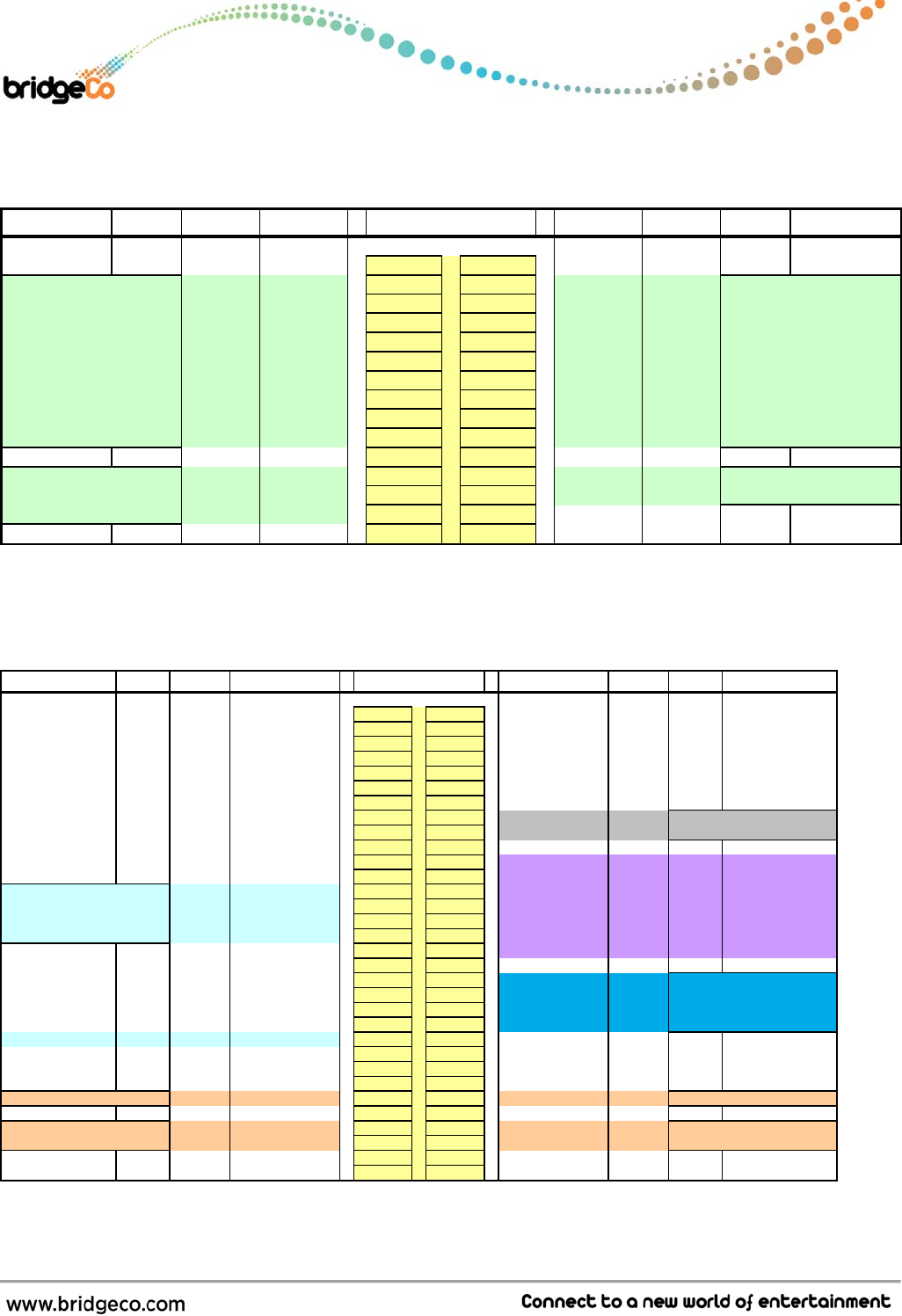
Preliminary Data Sheet: CX Series
JukeBlox Networked Media Modules
dat_CX860_CX870_1_7_datasheet_c.doc PRELIMINARY - CONFIDENTIAL Version 1.7 – May 13th 2011 - Page 18 of 23
J1 – LCD Connector
Function GPIO IC PIN Signal Signal IC PIN GPIO Function
GND 12
GND
Y7 LCDD0 34
LCDD1 W7
V7 LCDD2 56
LCDD3 Y6
W6 LCDD4 78
LCDD5 V6
U6 LCDD6 910
LCDD7 Y5
W5 LCDD8 11 12 LCDD9 V5
U5 LCDD10 13 14 LCDD11 Y4
W4 LCDD12 15 16 LCDD13 V4
U4 LCDD14 17 18 LCDD15 Y3
W3 LCDD16 19 20 LCDD17 Y2
GND 21 22 GND
Y9 LCDCLK 23 24 LCDCTRL0 W9
Y8 LCDCTRL1 25 26 LCDCTRL2 W8
V8 LCDCTRL3 27 28 GND
GND 29 30 GND
PIN Number
LCD Interface
LCD Interface
LCD Interface
LCD Interface
Note: The IC PIN column indicates the pin number on the DM860 or DM870 integrated circuit. This allows
for easy cross-reference to the DM860 or DM870 data sheet information.
J3 – Low Density Connector
Function GPIO IC PIN Signal Signal IC PIN GPIO Function
GND 12GND
VIN (+3.3) 34RXD0
VIN (+3.3) 56TXD0
GND 78GND
VIN (+1.9) 910VIN (+1.2)
VIN (+1.9) 11 12 VIN (+1.2)
GND 13 14 GND
Free GPIO-15 N18 NWAIT 15 16 RXD1 B17
iPod NDETECT GPIO-19 L18 NCS2 17 18 TXD1 A17
NRESET 19 20 GND
F4 3V3RTC 21 22 AV2CTRL1 T1 MCLK
GND 23 24 AV2CTRL0 T2 LRCK
F17 SPI_DIN 25 26 AV2CLK R4 SCLK
E17 SPI_DOUT 27 28 AV2DATA2 T4 A/D data 0
D17 SPI_CLK 29 30 AV2DATA0 U2 D/A data 0
D16 SPI_NCS0 31 32 AV4DATA1 W2 SPDIF output
Free GPIO-17 D15 NCS3 33 34 AV4DATA0 Y1 SPDIF input
GND 35 36 GND
E-GPIO_NCS/TBA GPIO-11 C16 SSMD7 37 38 USB_DN A1
I2C SDA GPIO-14 V1 AV3CTRL1 39 40 USB_DP B1
I2C SCL GPIO-13 V2 AV3CTRL0 41 42 USBVBUSDRV
GND 43 44 USB_VBUS
SPI_REQ GPIO-06 L1 PDOUT1 45 46 GND
Factory Reset GPIO-04 M1 PDOUT0 47 48 SSMD5 K20 GPIO-09 E-GPIO_SDI/TBA
IR input GPIO-05 M2 VCO0 49 50 SSMD4 C15 GPIO-08 E-GPIO_SDO/TBA
GND 51 52 GND
ETH_LED_SPEED 53 54 ETH_LED_ACT
iPod Access Power GPIO-03 V11 MIITXCLK 55 56 SSMD6 B16 GPIO-10 E-GPIO_CLK/TBA
ETH_RXN 57 58 ETH_RXP
ETH_TXN 59 60 ETH_TXP
Free GPIO-00 MMIICRS 61 62 MIICOL GPIO-01 Free
GND 63 64 GND
PIN Number
Debug UART
USB
SPI
Ethernet
EthernetEthernet
Ethernet
Note: The IC PIN column indicates the pin number on the DM860 or DM870 integrated circuit. This allows
for easy cross-reference to the DM860 or DM870 data sheet information.
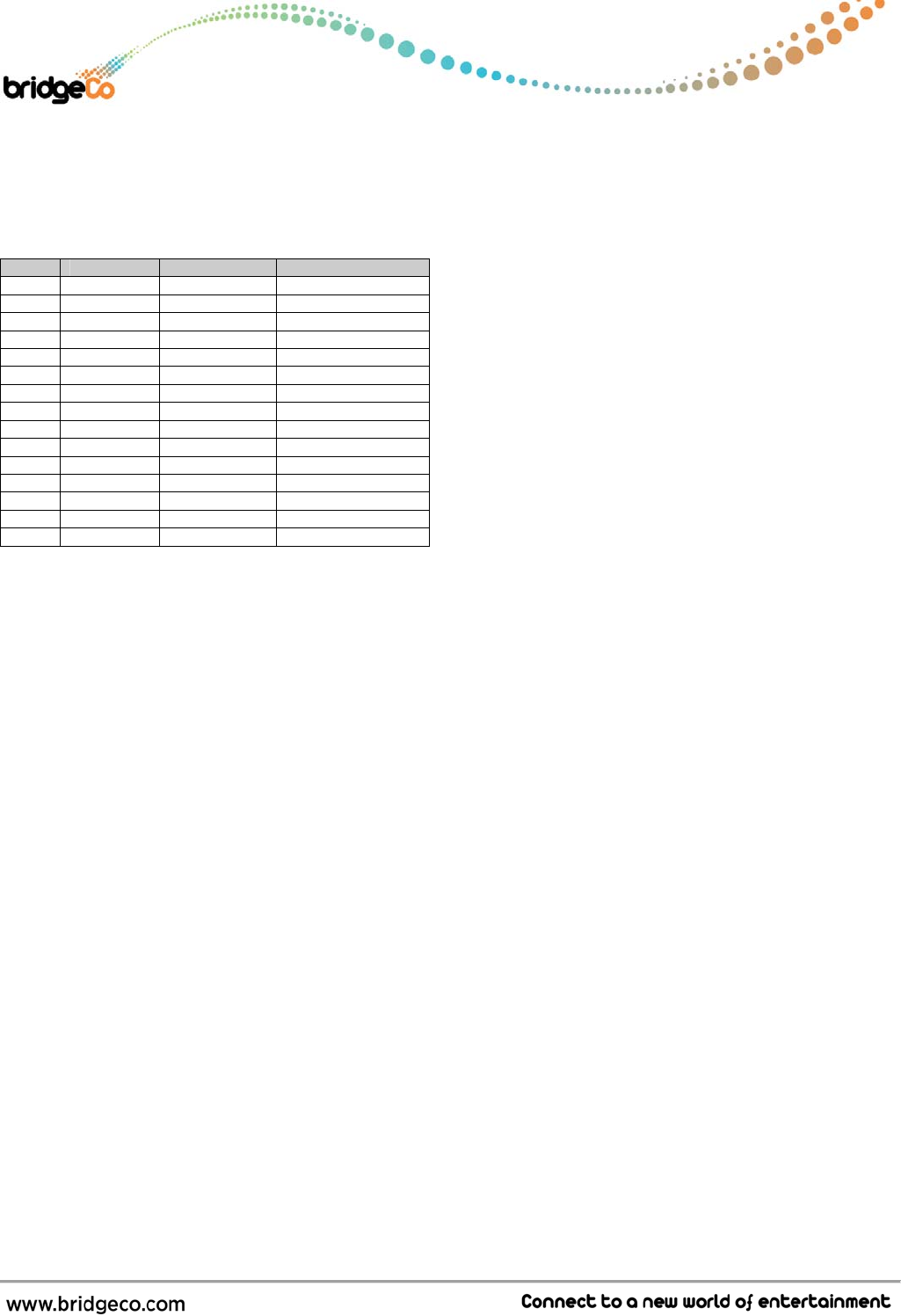
Preliminary Data Sheet: CX Series
JukeBlox Networked Media Modules
dat_CX860_CX870_1_7_datasheet_c.doc PRELIMINARY - CONFIDENTIAL Version 1.7 – May 13th 2011 - Page 19 of 23
8.2.3 GPIO Assignments
GPIO Assignments for J3 64-pin Low Density Connector
GPIO PIN Name PIN Number Function
00 MMIICRS 61 Free
01 MIICOL 62 Free
03 MIITXCLK 55 iPOD Access Power
04 PDOUT0 47 Factory Reset
05 VCO0 49 IR Input
06 PDOUT1 45 Host NIREQ
08 SSMD4 50 E_GPIO_SDO/TBA
09 SSMD5 48 E_GPIO_SDI/TBA
10 SSMD6 56 E_GPIO_CLK/TBA
11 SSMD7 37 E_GPIO_NCS/TBA
13 AV3CTRL0 41 I2C_SCL
14 AV3CTRL1 39 I2C_SDA
15 NWAIT 15 Free
17 NCS3 33 Free
19 NCS2 17 IPOD NDETECT
Note: Not all 20 GPIO signals are brought out to J3 64-pin low density connector.
9. Application Guidelines
9.1 Power Supply sequencing and Reset Timing
There are strict power sequencing and reset timing requirements.
Power up the I/O voltage (3.3V) first and hold NRESET_MOD low.
The core voltage (1.2V) must never be higher than (I/O voltage +0.5 V).
The core voltage (1.2V) must be within the specified core voltage limits less than 300ms after
the I/O voltage (3.3V) reaches the specified I/O voltage limits.
Throughout the power down process, the 3.3V supply must maintain a higher voltagethan the
1.2V supply, until both have reached ground potential.
To assure a proper IC reset, the power supplies must be present for a minimum time of 2ms
before NRESET_MOD is de-asserted.
Please see the power and reset timing figure in Section 9.1.1 below.
About 1.9V, the arrival of 1.9V supply should lag behind the arrival of the 3.3V. The delay between
the 1.9V and the 3.3V is not critical. Typical delay is approximately 10ms, for example using 10kohm
resistor and 0.1uF capacitor on the enable pin of a 1.9V dc-to-dc converter.
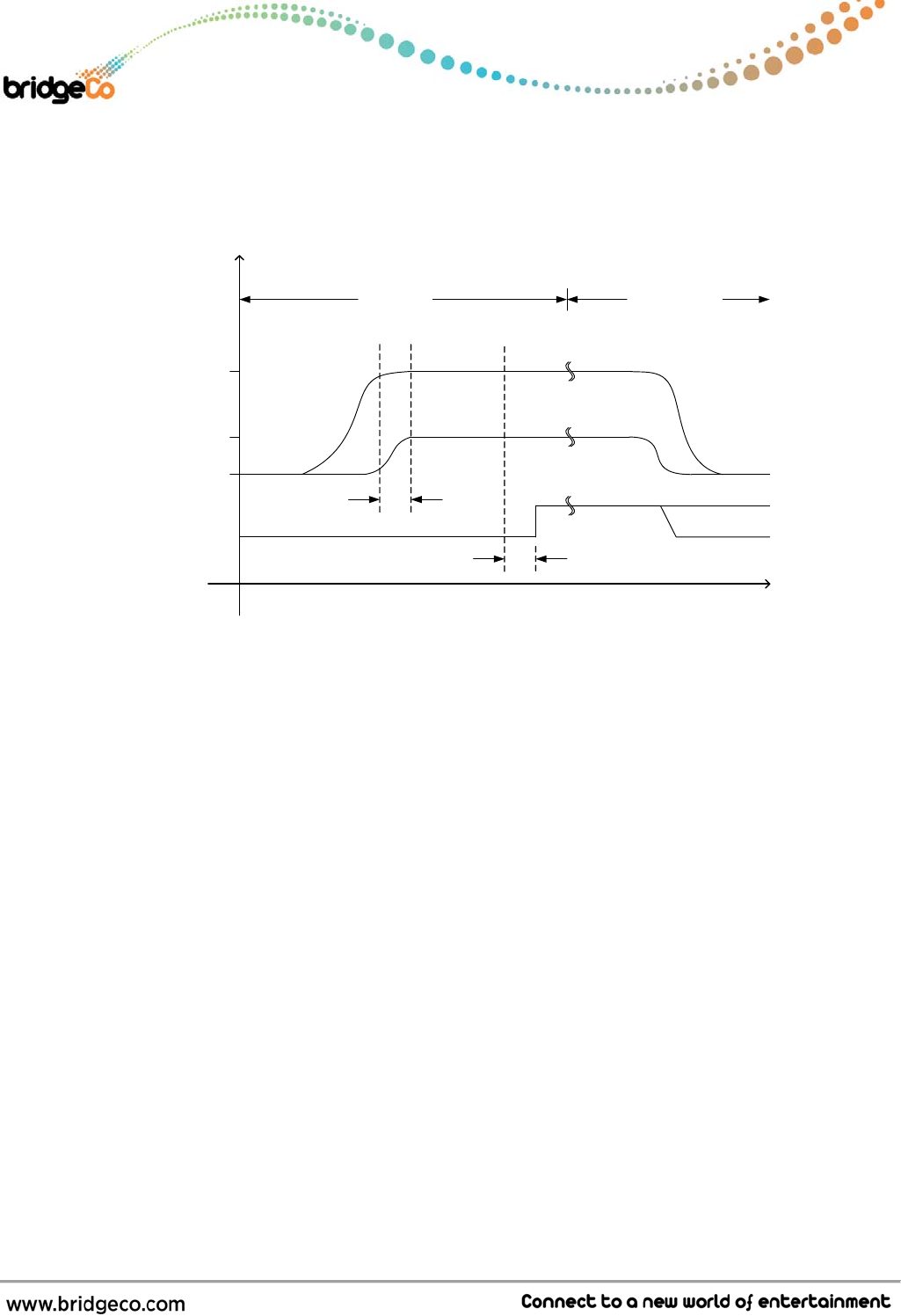
Preliminary Data Sheet: CX Series
JukeBlox Networked Media Modules
dat_CX860_CX870_1_7_datasheet_c.doc PRELIMINARY - CONFIDENTIAL Version 1.7 – May 13th 2011 - Page 20 of 23
9.1.1 Power up, Reset and Power Down Timing
Time
Voltage
NRESET_MOD
0V
+1.2V
+3.3V
< 300ms
>= 2ms
Power Up Power Down
9.2 RF Considerations
Note that overall system, RF and WiFi performance is significantly affected by the product design,
environment and the application. It is the responsibility of the product designer to ensure proper
system level shielding (if required) and to verify performance and fitness for the given product
features and applications.
The WiFi performance will be affected by the RF environment surrounding the CX module. Please
ensure that the CX module is positioned in a “quiet” RF environment, as far away as possible from
high frequency clock signals and any other sources of RF energy. Also, make sure the antenna is not
shielded by any metal objects, for example loudspeakers or other metal parts. Please make sure that
the power supplies, in particular the +1.9V supply, are quiet and free from noise.
BridgeCo recommends that systems implementing AirPlay should use a module configuration that
includes on-module shielding, as well as paying particular attention to system configuration and
shielding.

Preliminary Data Sheet: CX Series
JukeBlox Networked Media Modules
dat_CX860_CX870_1_7_datasheet_c.doc PRELIMINARY - CONFIDENTIAL Version 1.7 – May 13th 2011 - Page 21 of 23
10. Revision Control
Revision Date / Author Remarks
V1.7 c May 13, 2011 / SHs Updated “Module Quality” Defect Rate field entry
Updated “Board Dimensions & Weight” drawings
Updated the “Electrical Specifications” table
Added another Note to the “Pin Descriptions” section
V1.7 b May 11, 2011 / SHs Updated Note 8 in “Pin Descriptions” table
Re-imported “Board Dimensions & Weight” drawings
Updated “Board Pictures” images
Updated board photo on Cover page
Updated the Feature list on Cover page
Updated J1, J2 & J3 “Connector PIN Assignments” tables:
removed Power column & re-organised columns
Changed “Application Notes” title to “Application Guidelines”
Updated Copyright date to “2011”
Updated Table of Contents font styling
V1.7 a May 6, 2011 / SHs Re-imported Block Diagram as a wmf file
Updated “Power up, Reset & Power down Timing” figure
Updated “Pin Descriptions” table
Re-organised text in “Power Supply sequencing & Reset Timing”
Re-imported J2 & J3 Connector PIN Assignment tables
V1.7 May 4, 2011 / SHs Added note to Module Weight section
Updated the Ordering Guide – Part Numbers & added new J
version
Added new text to the Board Pictures section
Updated all Mechanical Drawings and added & removed Notes
Updated the J3 Low Density Connector table
Updated the GPIO Assignment table
Added new Power Supply & Timing figure
Updated the text in the “Power Supply sequencing and Reset
Timing” section
Updated the Key Connections table
Updated “Key Connections” section title to “Pin Descriptions”
Updated “Detailed Connector PIN Descriptions” section title to
“Connector PIN Assignments”
Updated J2 Media Connector table
V1.6 d March 3, 2011 / SHs Updated J3 Low Density Connector table
Update GPIO Assignments section and table
V1.6 c February 24, 2011 / SHs Updated all mechanical drawings in “Board Dimensions and
Weights” section
Deleted warning note in “Board Dimensions and Weights”
section
V1.6 b February 23, 2011 / SHs Updated “J3-Low density connector” pin description table
Updated “GPIO Assignments” table
V1.6 February 11, 2011 / SHs Entirely updated the “Ordering Guide”
Added a Note to the “Ordering Guide”
Updated the subsection titles for the “Board Pictures” section
Updated the Block Diagram – changed ‘WiFi Antenna’ to ‘Ext.
Antenna’

Preliminary Data Sheet: CX Series
JukeBlox Networked Media Modules
dat_CX860_CX870_1_7_datasheet_c.doc PRELIMINARY - CONFIDENTIAL Version 1.7 – May 13th 2011 - Page 22 of 23
V1.5 b January 27, 2011 / SHs Added Note to “Board Dimensions and Weight” section
V1.5 a January 24, 2011 / SHs Updated the “Ordering Guide” – removed Mfg column and
consolidated into one table
Updated the Header to reflect Preliminary nature of datasheet
V1.5 January 22, 2011 / SHs Updated the datasheet to be a Preliminary Datasheet
Added new feature to Summary on Front Page
Updated “J3 - Low Density Connector” table
Updated “GPIO Assignments” table
Added note to “Board Dimensions & Weight – Side Views of
CX870 module” section
Updated text in “Application Notes – Power Supply Sequencing
& Reset Timing” section
Updated “Block Diagram”
Updated text in “Connectors & Connections – WLAN UFL
Antenna Connector” section
V1.4 b January 11, 2011 / SHs Updated the Application Notes, RF Considerations section
V1.4 January 3, 2011 / SHs Updated the module photo on the Title page
Updated the Application Notes, RF Considerations section
V1.3 December 23, 2010 / SHs Updated Ordering Guide
Added Notes to Ordering Guide
Updated Block Diagram
Updated “J3 – Low Density Connector” table
Updated “Electrical Specifications” table
Added Power Consumption data to “Electrical Specifications”
table
Updated the Board Dimensions and Weight images
Updated the “GPIO Assignments” table
Added another Application Note
Added titles to Application Notes
V1.2 December 19, 2010 / SHs Inserted CX860 and CX870 Module Weights
Updated module image on Front Page
V1.1 December 13, 2010 / SHs Added the Ordering Guide.
Updated the Block Diagram.
Updated the “Electrical Specifications” table
Updated the “Absolute Maximum Ratings” table
Updated the Notes for “Regulatory Compliance and Quality”
section
Updated “Key Connections” table
Updated “J2 – Media Connector” table
Updated “J3 – Low Density Connector” table
Updated “GPIO Assignments” table
Added Board Pictures
Replaced Mechanical Drawings in “Board Dimensions and
Weight” section
V1.0 October 18, 2010 / SHs Initial Version
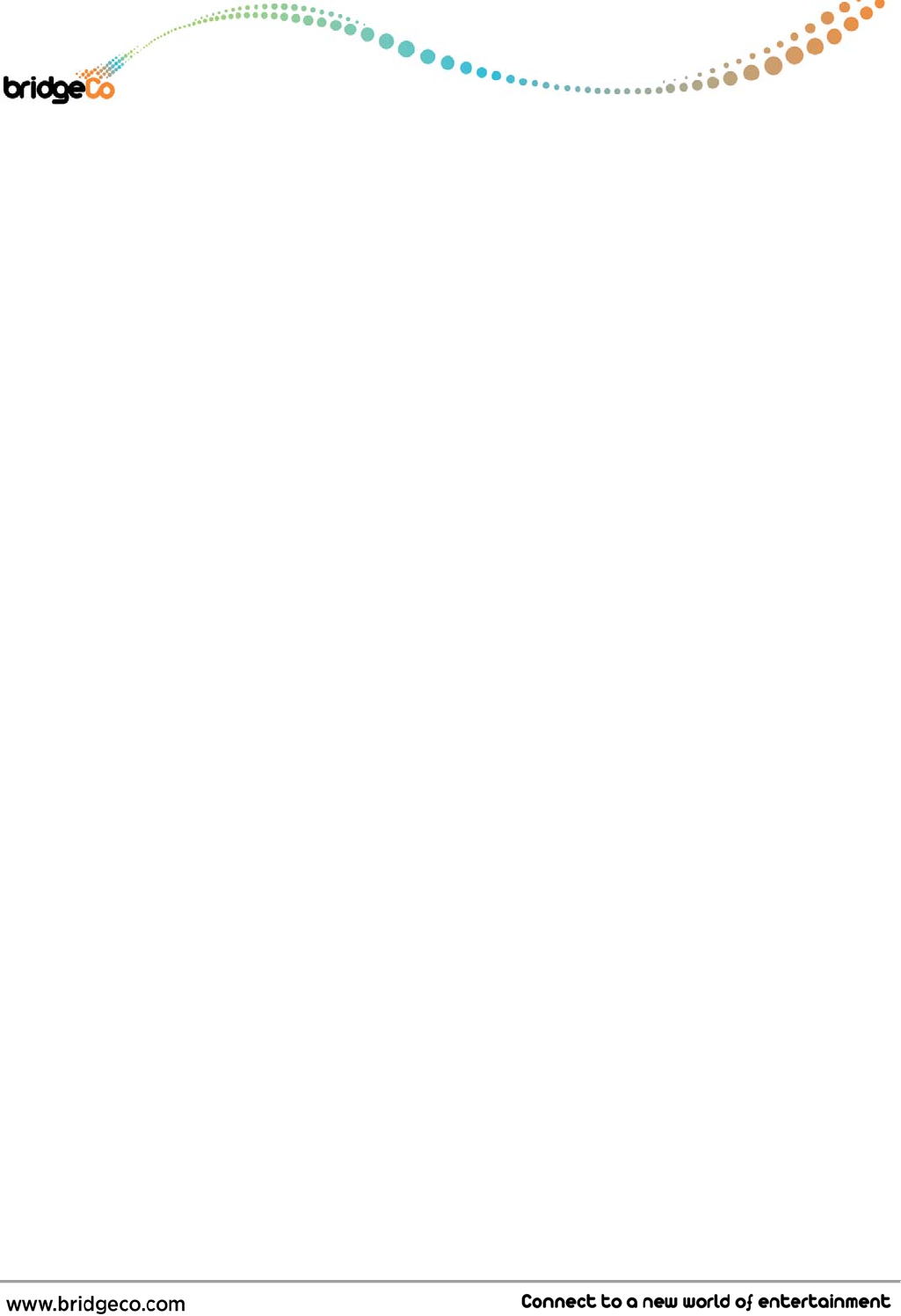
Preliminary Data Sheet: CX Series
JukeBlox Networked Media Modules
dat_CX860_CX870_1_7_datasheet_c.doc PRELIMINARY - CONFIDENTIAL Version 1.7 – May 13th 2011 - Page 23 of 23
Module Revision History
To be determined.
© 2011 by BridgeCo Inc
All rights reserved. This document is the sole property of BridgeCo. It contains information
proprietary to BridgeCo. Reproduction or duplication by any means of any portion of this document
without the prior written consent of BridgeCo is expressly forbidden.
Trademarks
The names of products of BridgeCo or other vendors and suppliers appearing in this document may
be trademarks or service marks of their respective owners which may be registered in some
jurisdictions.
Warranty Limitations
BridgeCo assumes no responsibility for inaccuracies, errors, or omissions in this document. BridgeCo
assumes no responsibility for the use of this information, and all use of such information shall be
entirely at the user’s own risk. Prices and specifications are subject to change without notice.
FEDERAL COMMUNICATIONS COMMISSION INTERFERENCE STATEMENT
This equipment has been tested and found to comply with the limits for a Class B digital device, pursuant to part
15 of the FCC Rules. These limits are designed to provide reasonable protection against harmful interference in
a residential installation. This equipment generates, uses and can radiate radio frequency energy and, if not
installed and used in accordance with the instructions, may cause harmful interference to radio communications.
However, there is no guarantee that interference will not occur in a particular installation. If this equipment does
cause harmful interference to radio or television reception, which can be determined by turning the equipment
off and on, the user is encouraged to try to correct the interference by one or more of the following measures:
-Reorient or relocate the receiving antenna.
-Increase the separation between the equipment and receiver.
-Connect the equipment into an outlet on a circuit different from that to which the receiver is connected.
-Consult the dealer or an experienced radio/ TV technician for help.
CAUTION:
Any changes or modifications not expressly approved by the grantee of this device could void the user's
authority to operate the equipment.
Labeling requirements
This device complies with Part 15 of the FCC Rules. Operation is
subject to the following two conditions: (1) this device may not cause
harmful interference, and (2) this device must accept any interference
received, including interference that may cause undesired operation.
RF exposure warning
This equipment must be installed and operated in accordance with provided instructions and the
antenna(s) used for this transmitter must be installed to provide a separation distance of at least 20 cm
from all persons and must not be co-located or operating in conjunction with any other antenna or
transmitter. End-users and installers must be provide with antenna installation instructions and
transmitter operating conditions for satisfying RF exposure compliance.
Information for the OEMs and Integrators
The following statement must be included with all versions of this document supplied to an
OEM or integrator, but should not be distributed to the end user.
This device is intended for OEM integrators only.
Please See the full Grant of Equipment document for other restrictions.
This device must be operated and used with a locally approved access point.
Information To Be Supplied to the End User by the OEM or Integrator
The following regulatory and safety notices must be published in documentation supplied to
the end user of the product or system incorporating an adapter in compliance with local regulations. Host
system must be labeled with "Contains FCC ID: ZQO-CX8703x “, FCC ID displayed on label.
The “x“is for different versions of CX870-3 serial modules, the label text should be updated according to the table shown in Chapter
4.The proper letter shown in Chapter 4 should be substituted for X. For example, The FCC ID:ZQO -CX8703B is for model CX870-3B.

Canada, Industry Canada (IC) Notices
This Class B digital apparatus complies with Canadian ICES-003 and RSS-210.
Operation is subject to the following two conditions: (1) this device may not cause interference, and (2) this device
must accept any interference, including interference that may cause undesired operation of the device.
Radio Frequency (RF) Exposure Information
The radiated output power of the Wireless Device is below the Industry Canada (IC) radio frequency exposure limits.
The Wireless Device should be used in such a manner such that the potential for human contact during normal
operation is minimized.
This device has also been evaluated and shown compliant with the IC RF Exposure limits under mobile exposure
conditions. (antennas are greater than 20cm from a person's body).
This device has been certified for use in Canada. Status of the listing in the Industry
Canada’s REL (Radio Equipment List) can be found at the following web address:
http://www.ic.gc.ca/app/sitt/reltel/srch/nwRdSrch.do?lang=eng
Additional Canadian information on RF exposure also can be found at the following web address:
http://www.ic.gc.ca/eic/site/smt-gst.nsf/eng/sf08792.html
Canada, avis d'Industry Canada (IC)
Cet appareil numérique de classe B est conforme aux normes canadiennes ICES-003 et RSS-210.
Son fonctionnement est soumis aux deux conditions suivantes : (1) cet appareil ne doit pas causer d'interférence et (2)
cet appareil doit accepter toute interférence, notamment les interférences qui peuvent affecter son fonctionnement.
Informations concernant l'exposition aux fréquences radio (RF)
La puissance de sortie émise par l’appareil de sans fil Dell est inférieure à la limite d'exposition aux fréquences radio
d'Industry Canada (IC). Utilisez l’appareil de sans fil Dell de façon à minimiser les contacts humains lors du
fonctionnement normal.
Ce périphérique a également été évalué et démontré conforme aux limites d'exposition aux RF d'IC dans des
conditions d'exposition à des appareils mobiles (les antennes se situent à moins de 20 cm du corps d'une personne).
Ce périphérique est homologué pour l'utilisation au Canada. Pour consulter l'entrée correspondant à l’appareil dans
la liste d'équipement radio (REL - Radio Equipment List) d'Industry Canada rendez-vous sur:
http://www.ic.gc.ca/app/sitt/reltel/srch/nwRdSrch.do?lang=eng
Pour des informations supplémentaires concernant l'exposition aux RF au Canada rendez-vous sur :
http://www.ic.gc.ca/eic/site/smt-gst.nsf/eng/sf08792.html
Information To Be Supplied to the End User by the OEM or Integrator
The following regulatory and safety notices must be published in documentation supplied to the end user of the product or system incorporating an
adapter in compliance with local regulations. Host system must be labeled with "Contains IC: 2581A-CX8703x “, IC ID displayed on label.
The “x“is for different versions of CX870-3 serial modules, the label text should be updated according to the table shown in Chapter 4.The proper letter
shown in Chapter 4 should be substituted for x. For example, The IC: 2581A-CX8703B is for model CX870-3B.

This radio transmitter IC: 2581A-CX8703D has been approved by Industry Canada to operate
with the antenna types listed below with the maximum permissible gain and required antenna
impedance for each antenna type indicated. Antenna types not included in this list, having a gain
greater than the maximum gain indicated for that type, are strictly prohibited for use with this
device.
Antenna List
No Manufacturer Part No. Antenna Type Peak Gain
1 Tyco Electronics 2174241-2 Inverted-F 2.67 dBi for 2.4 GHz